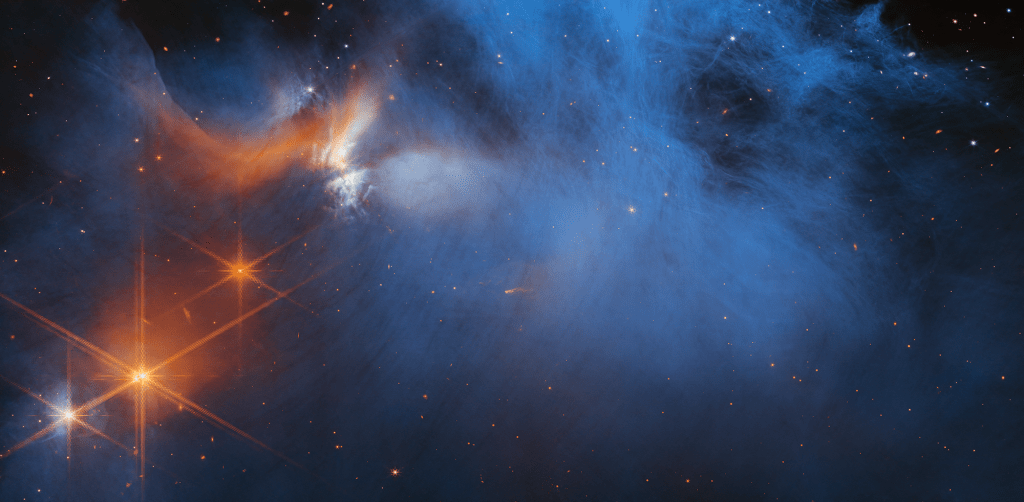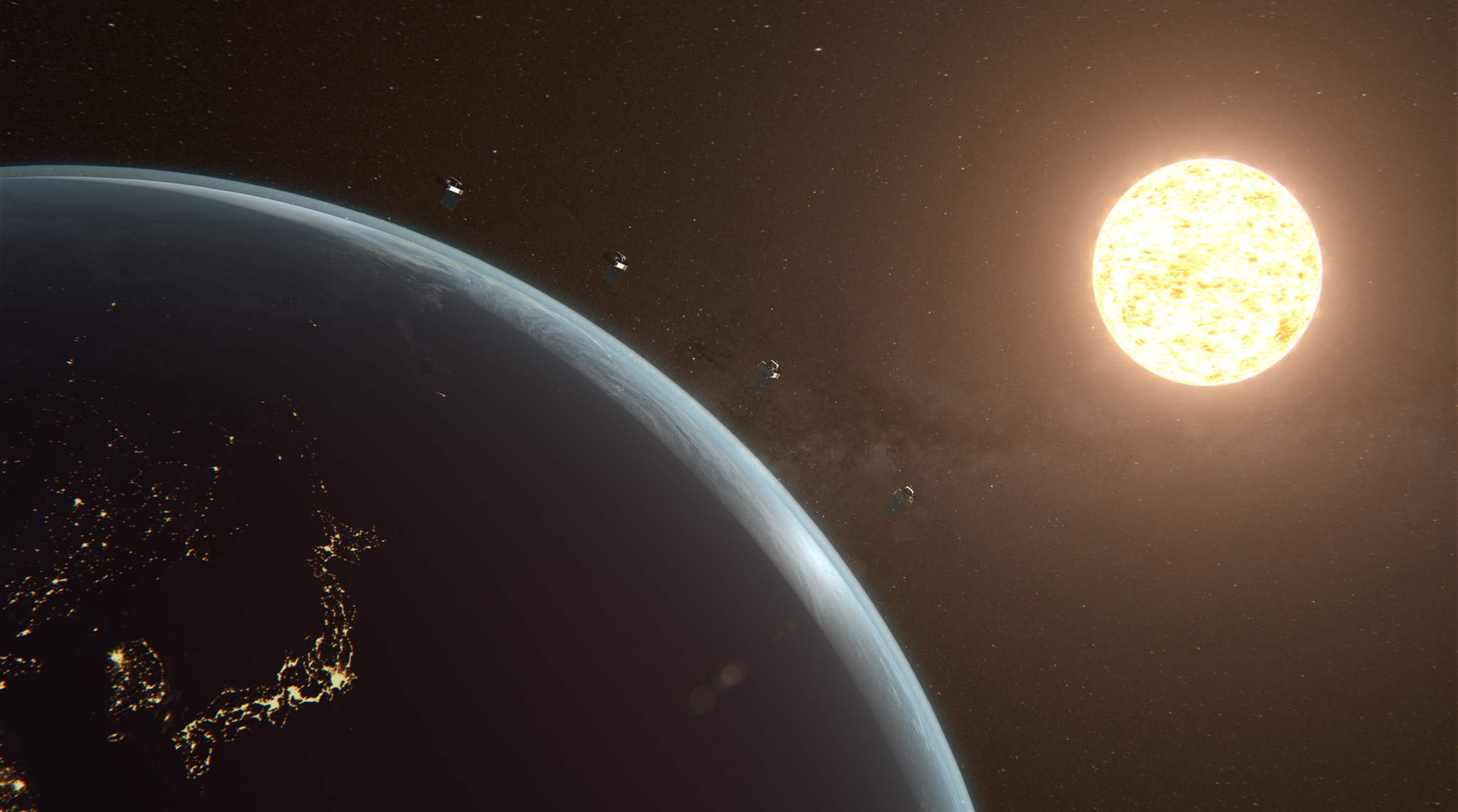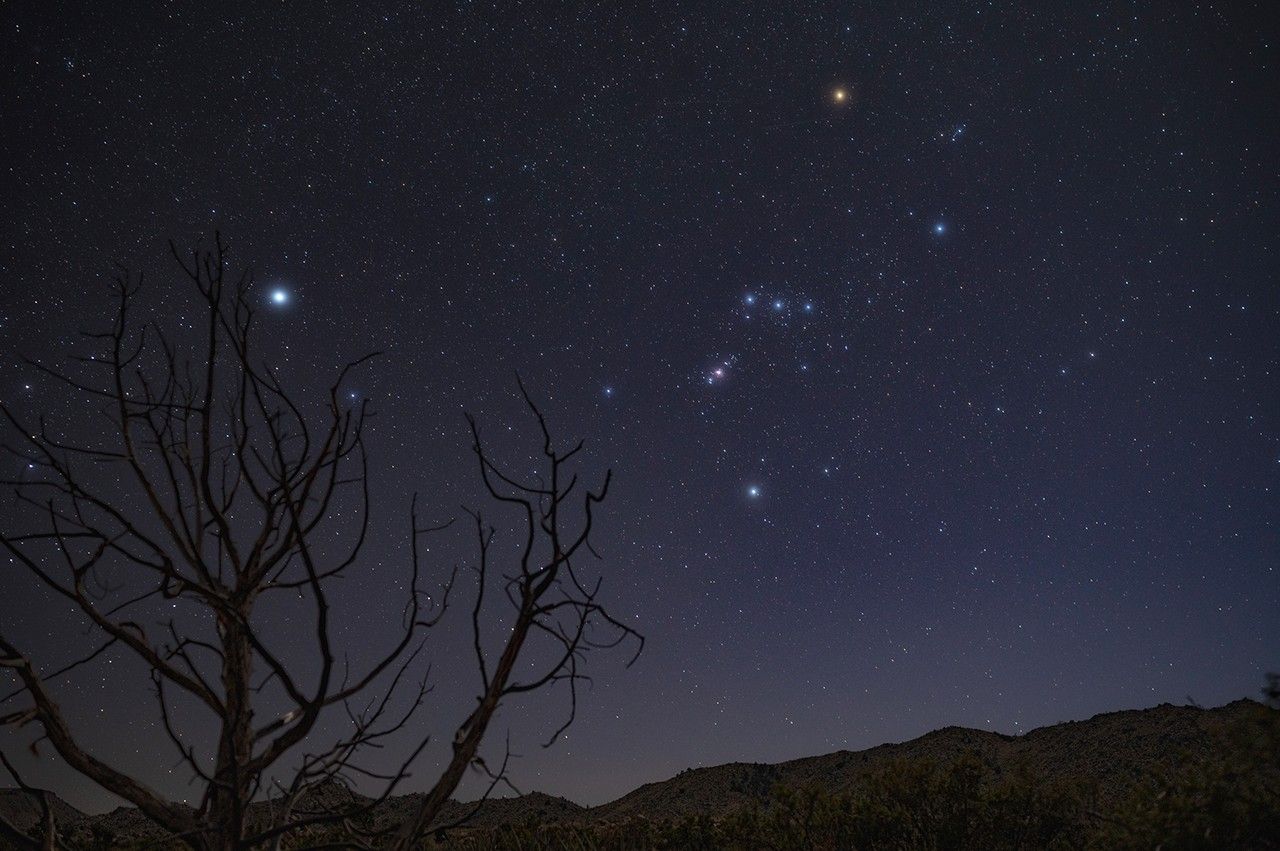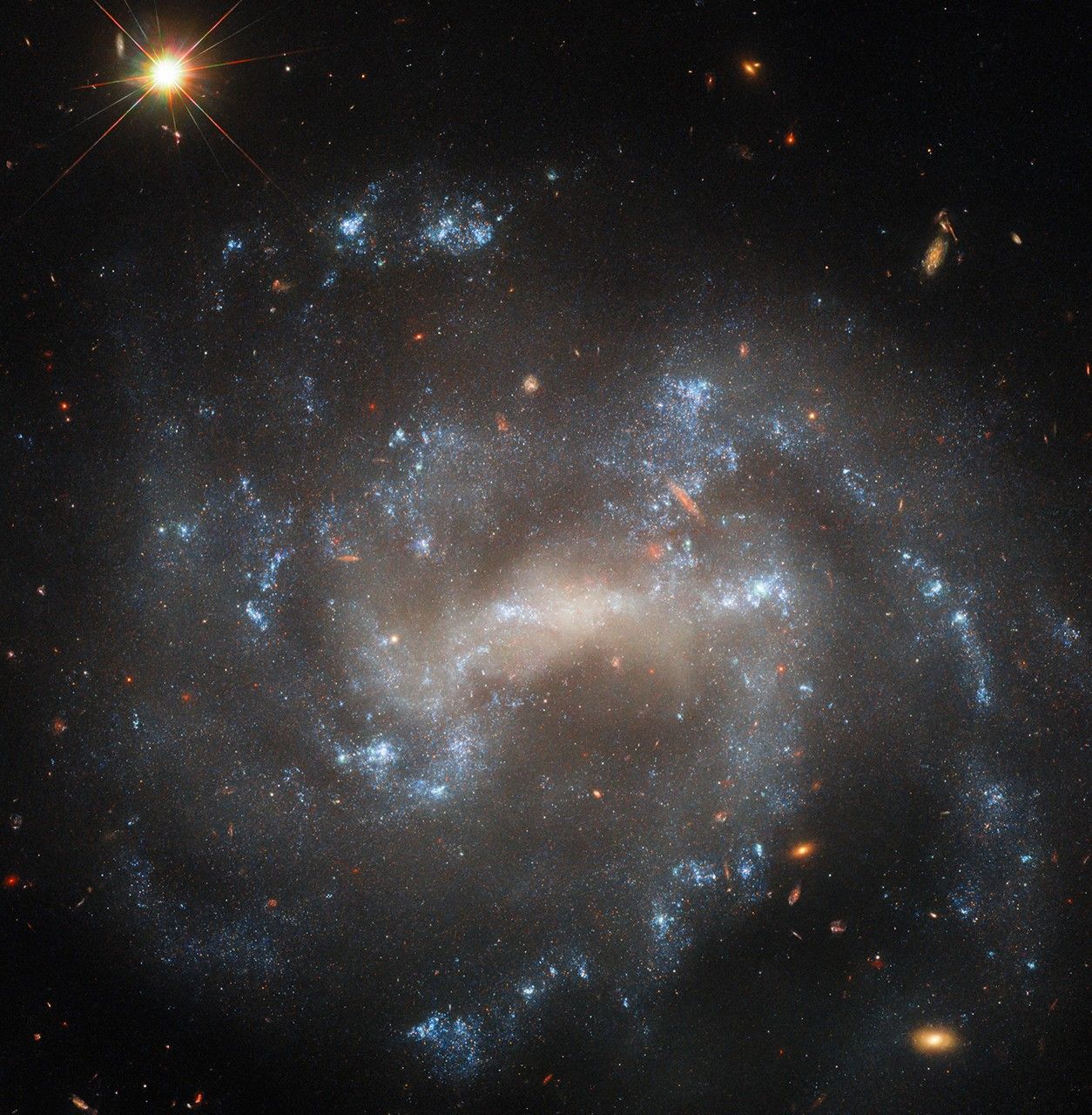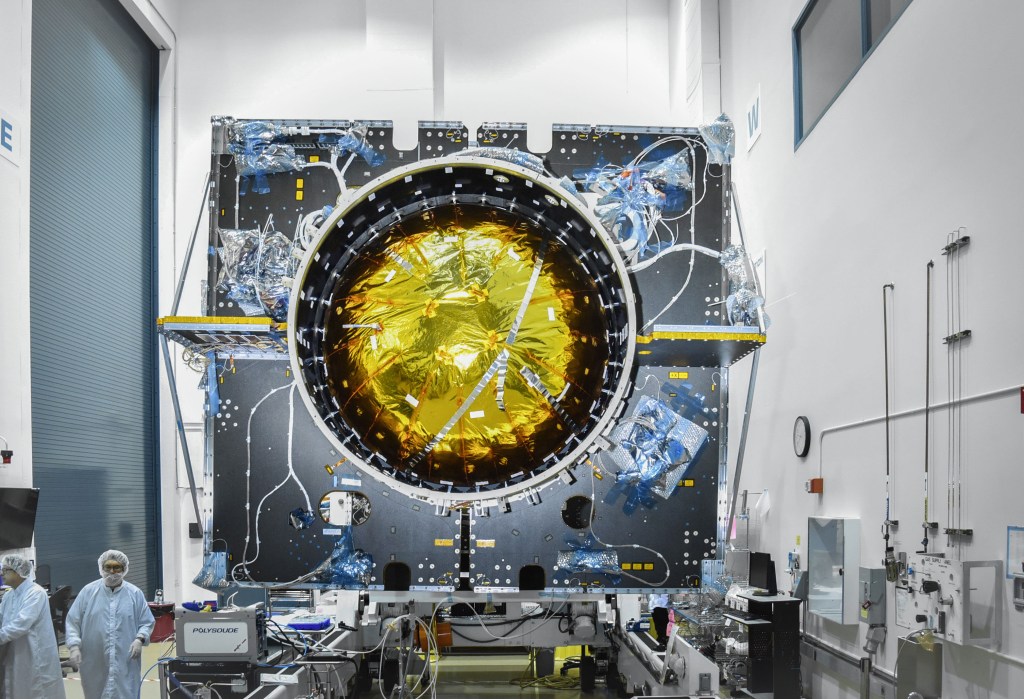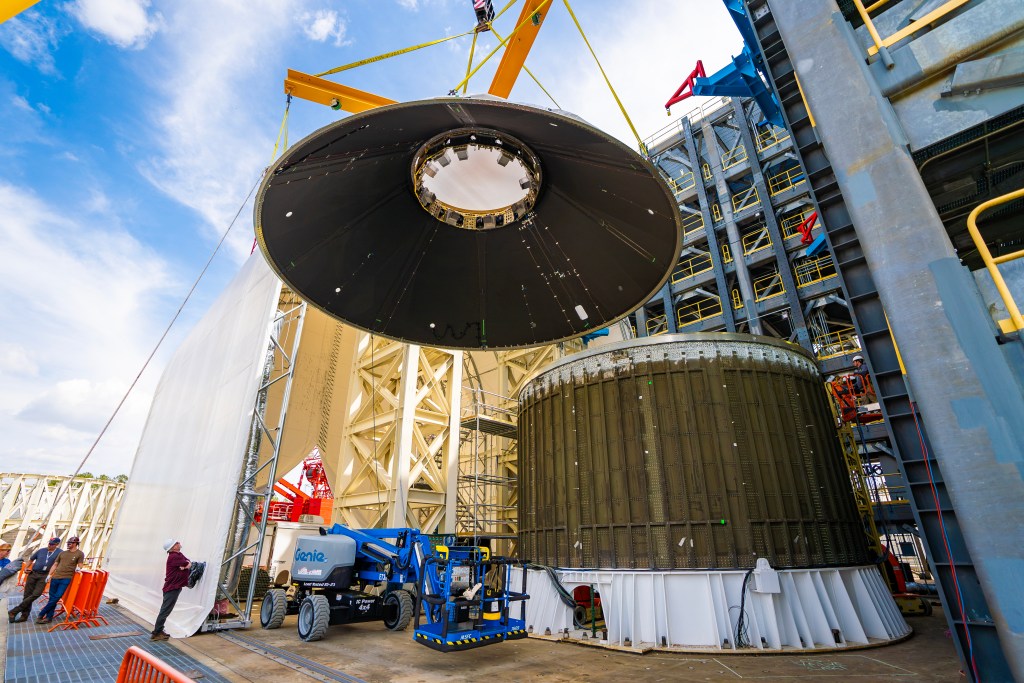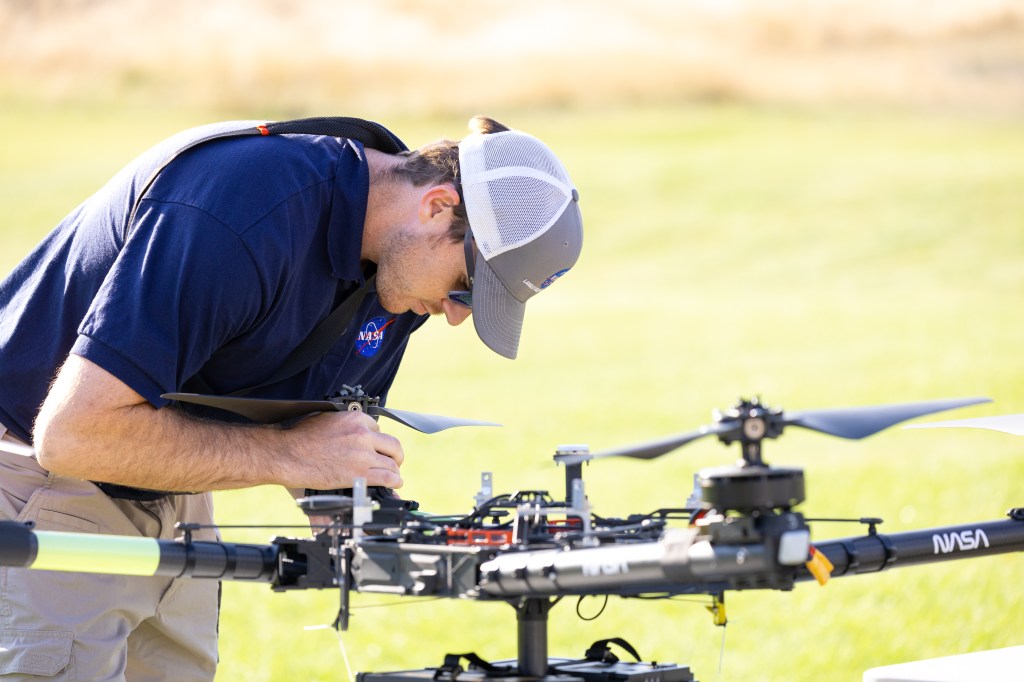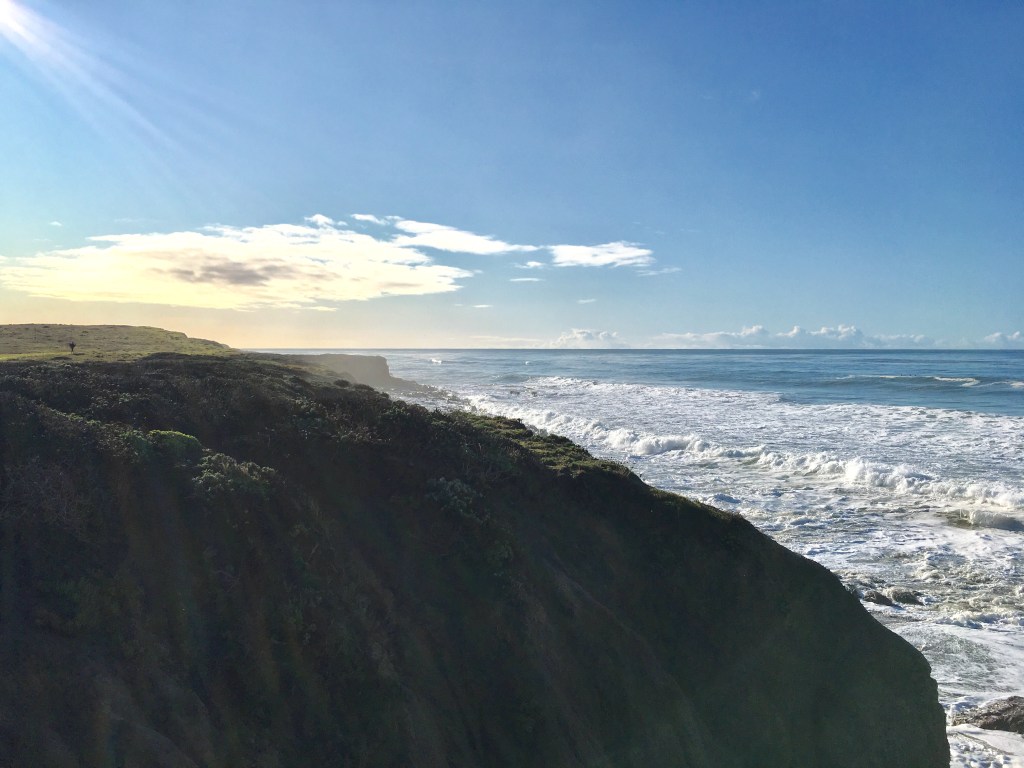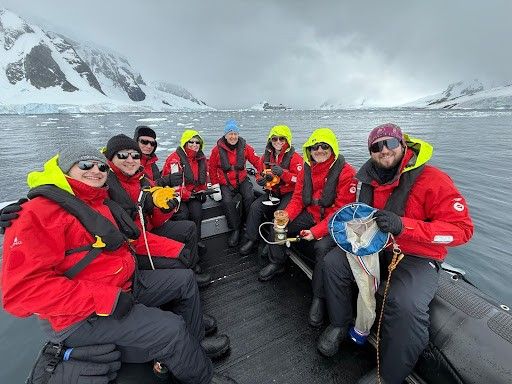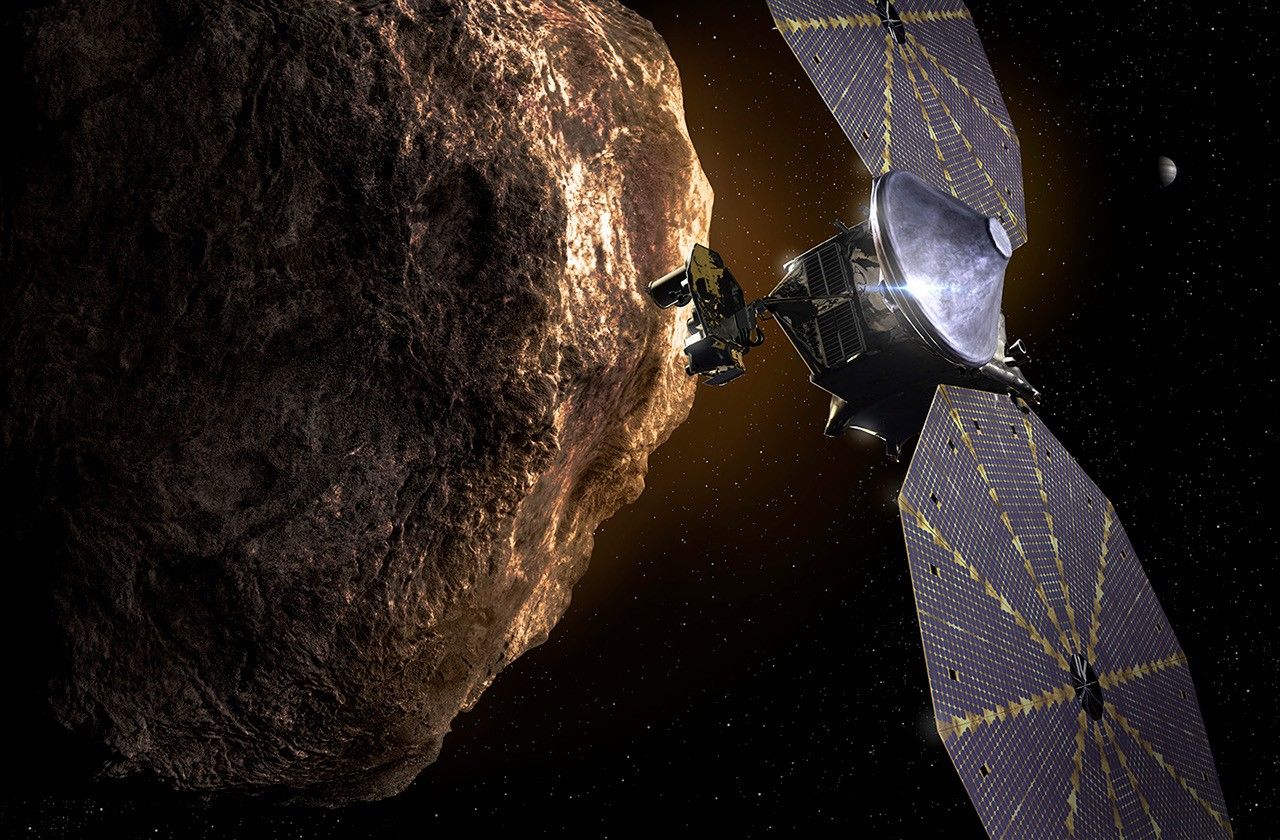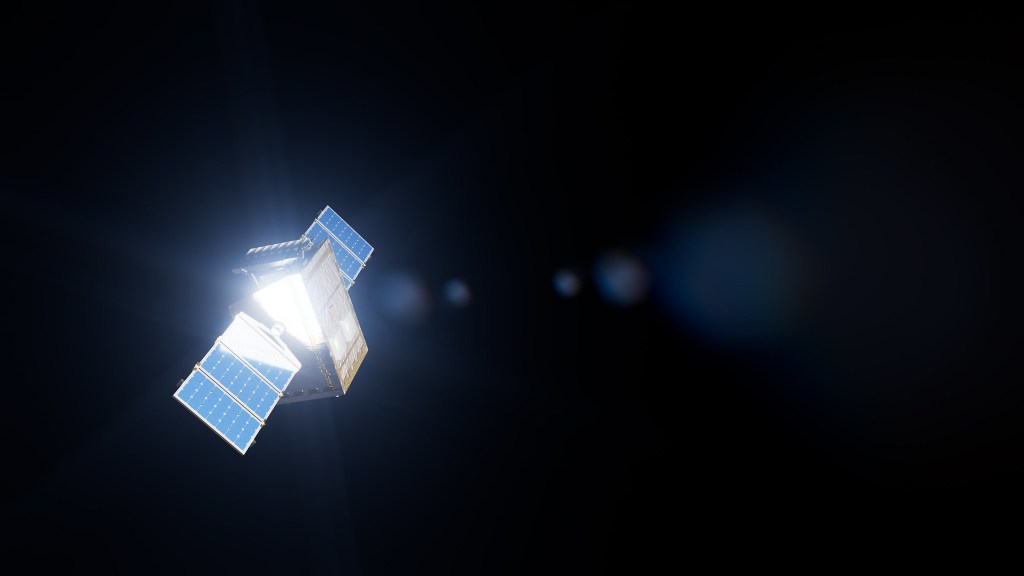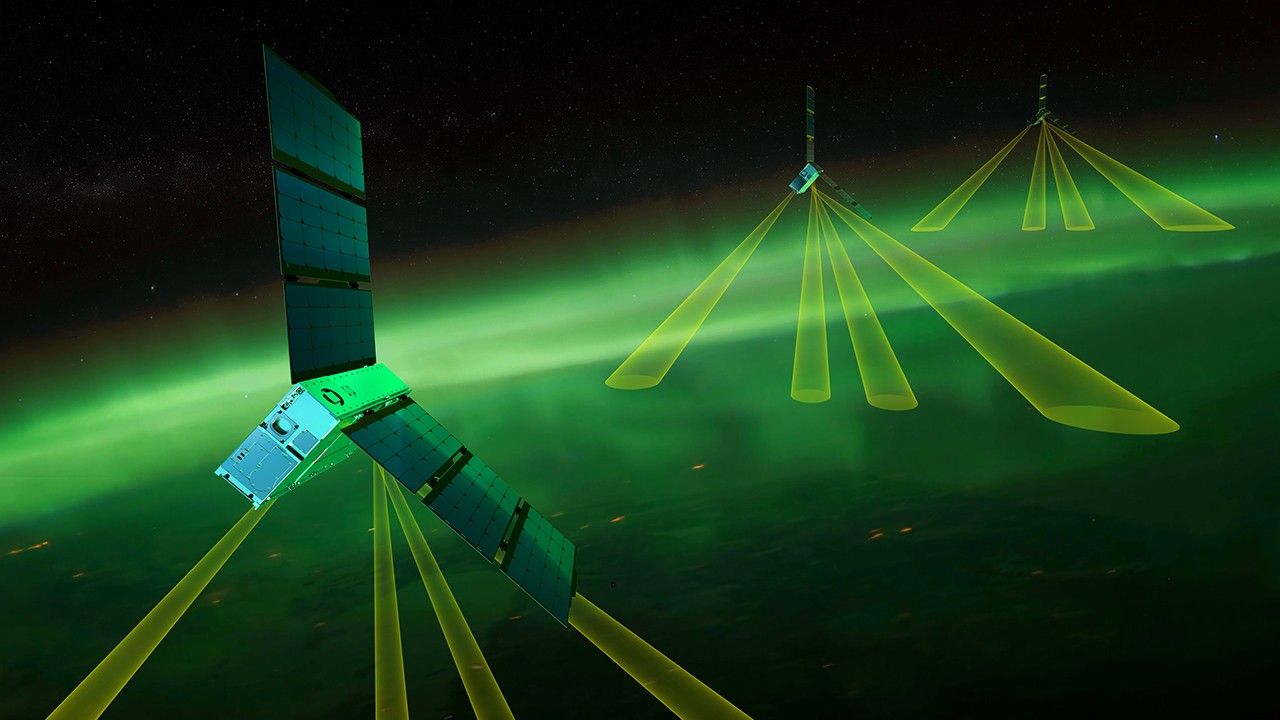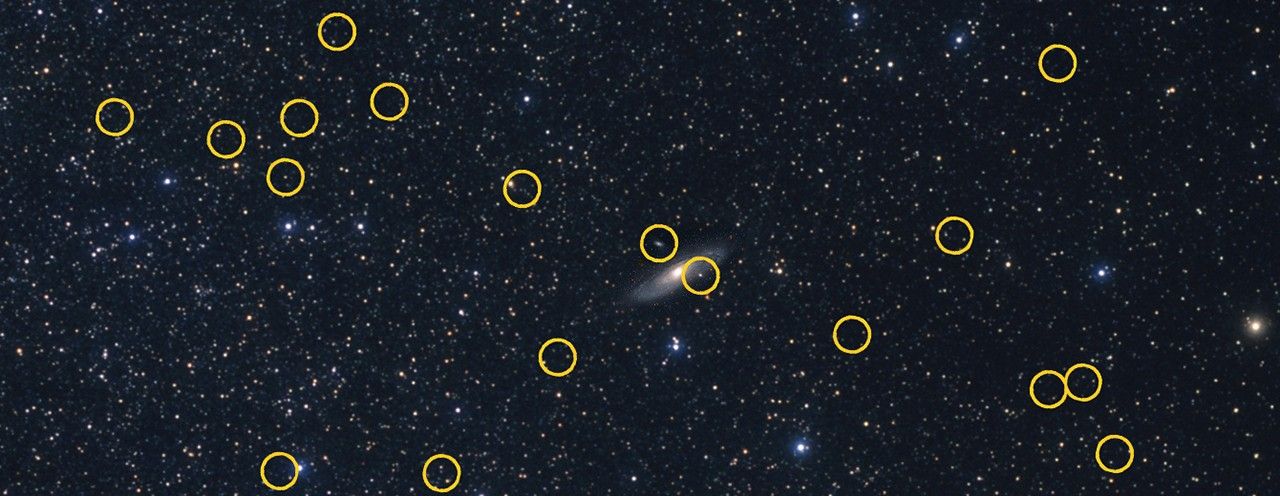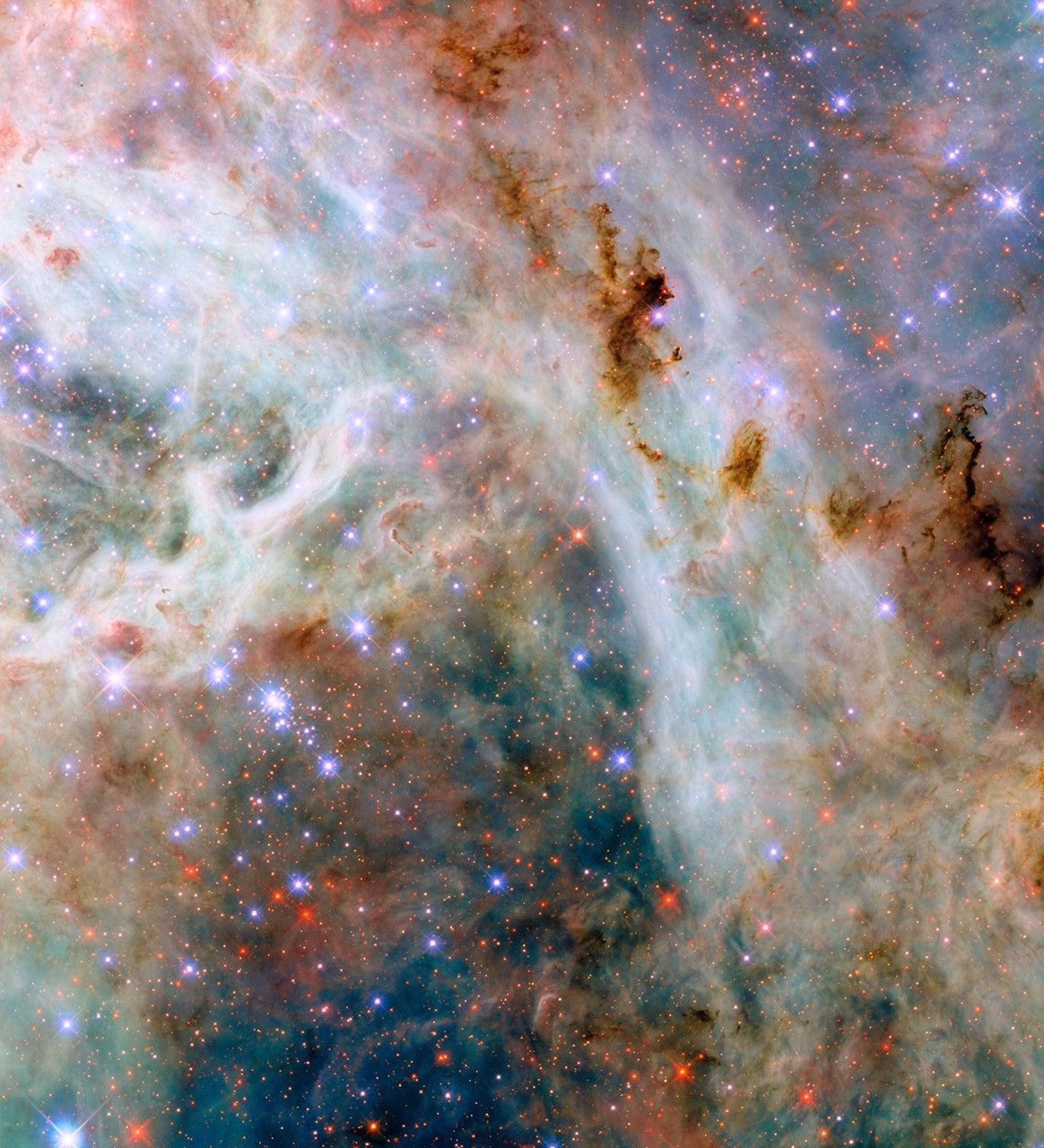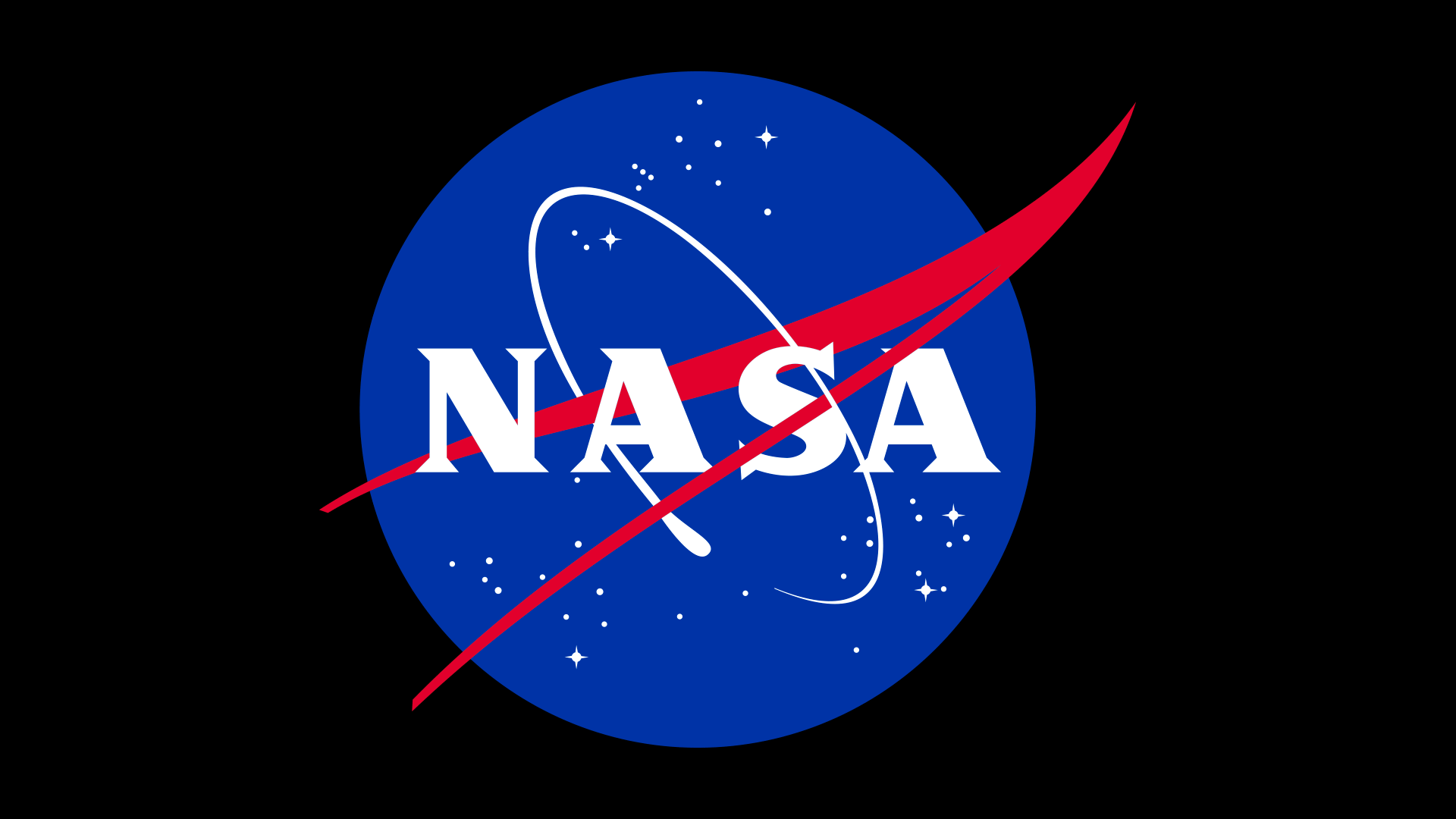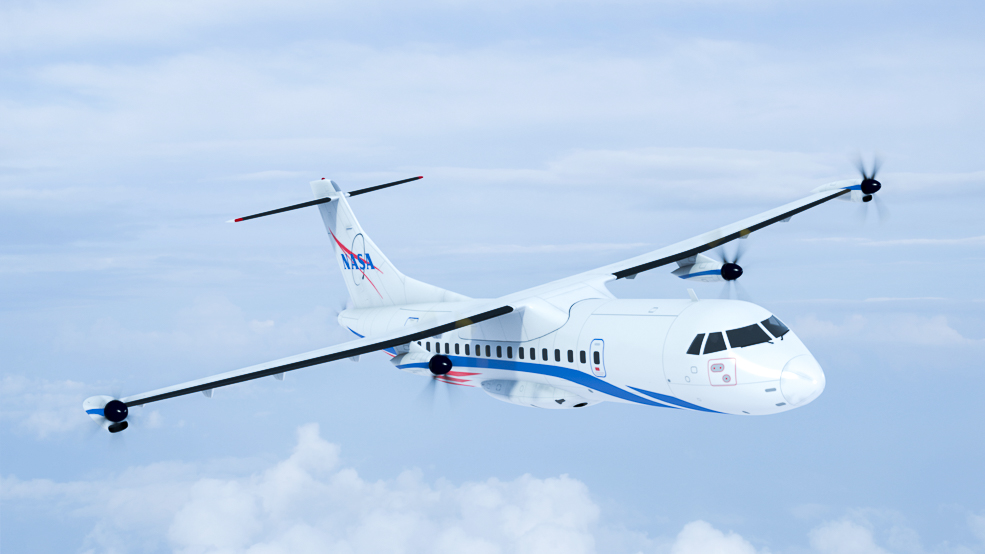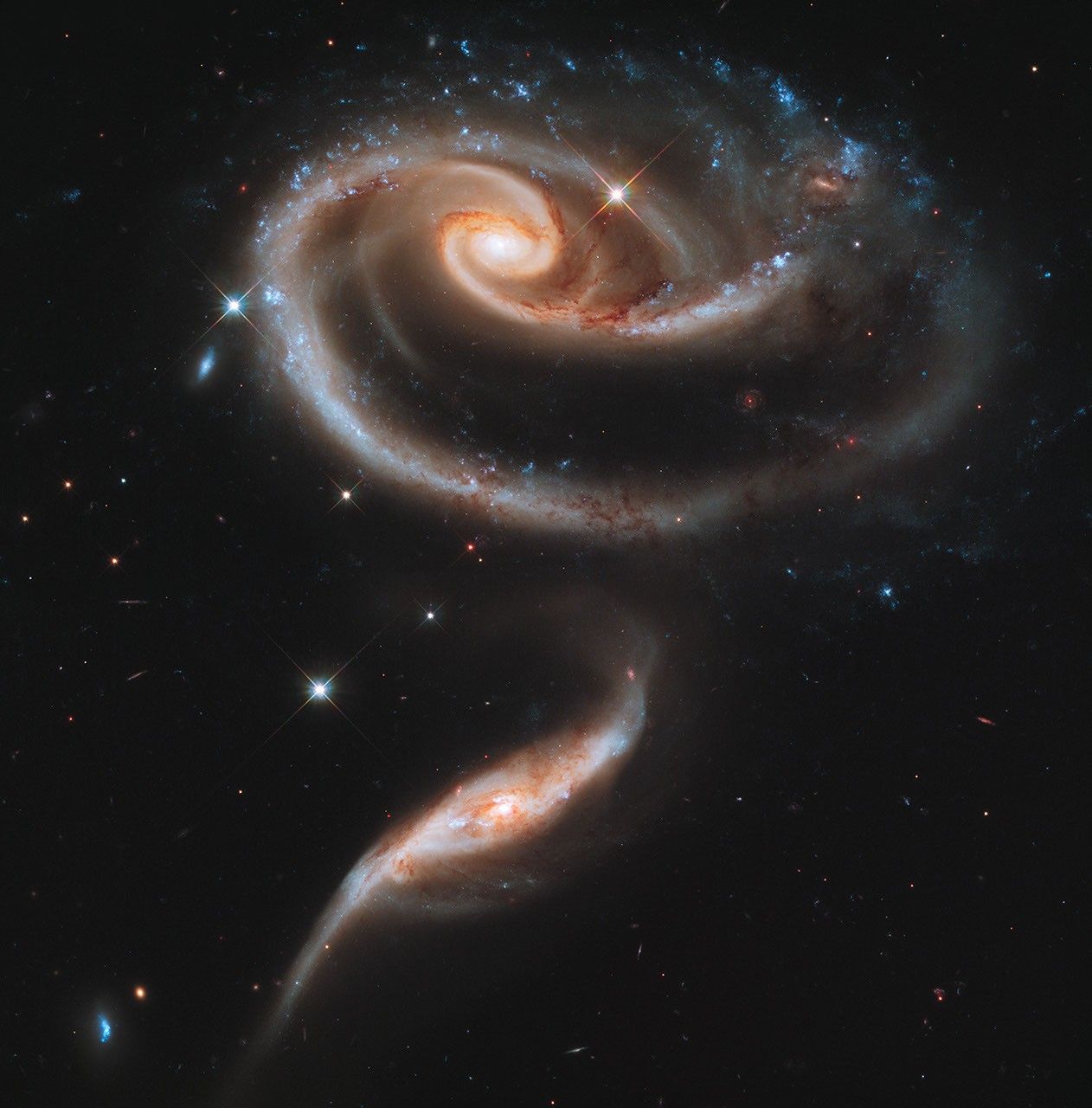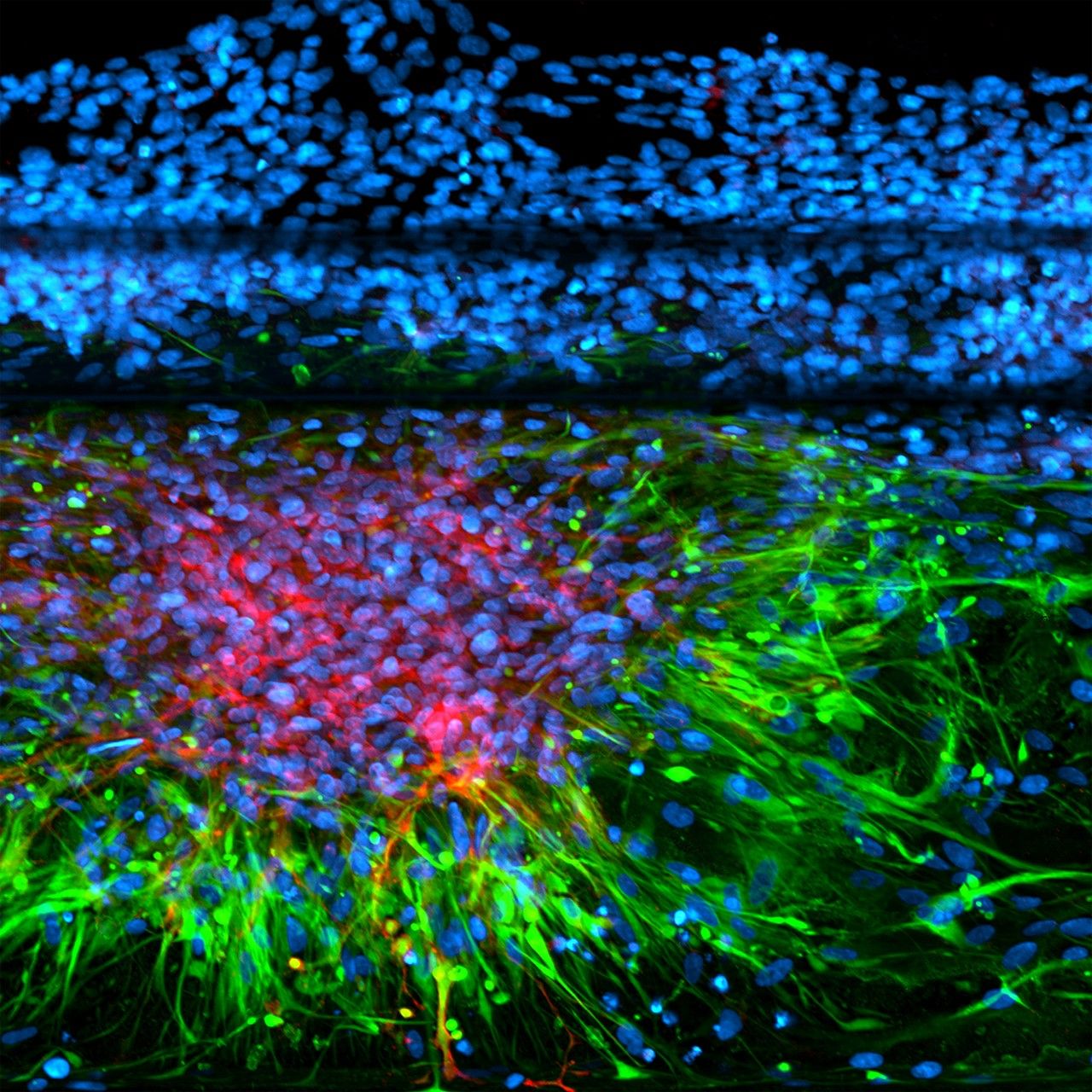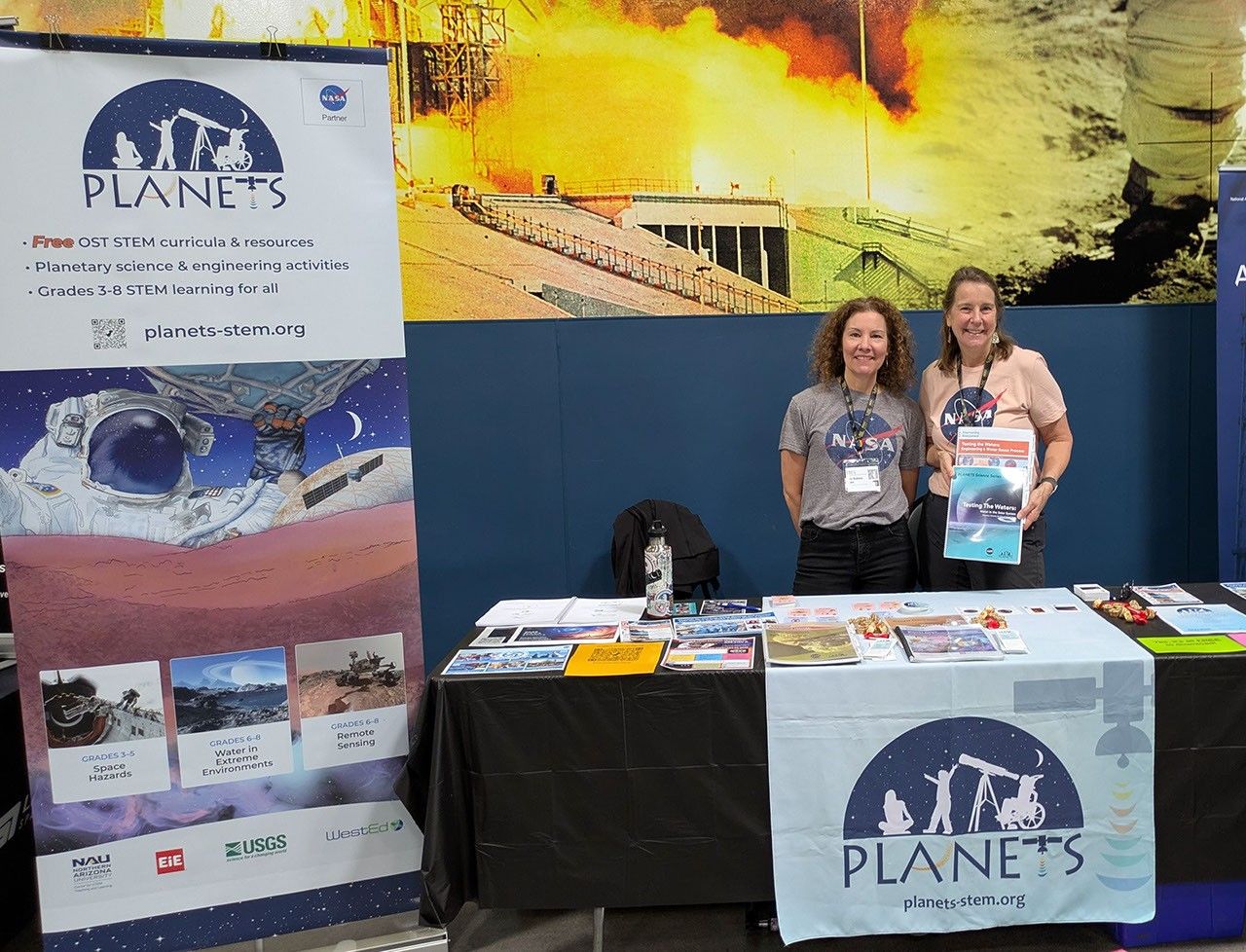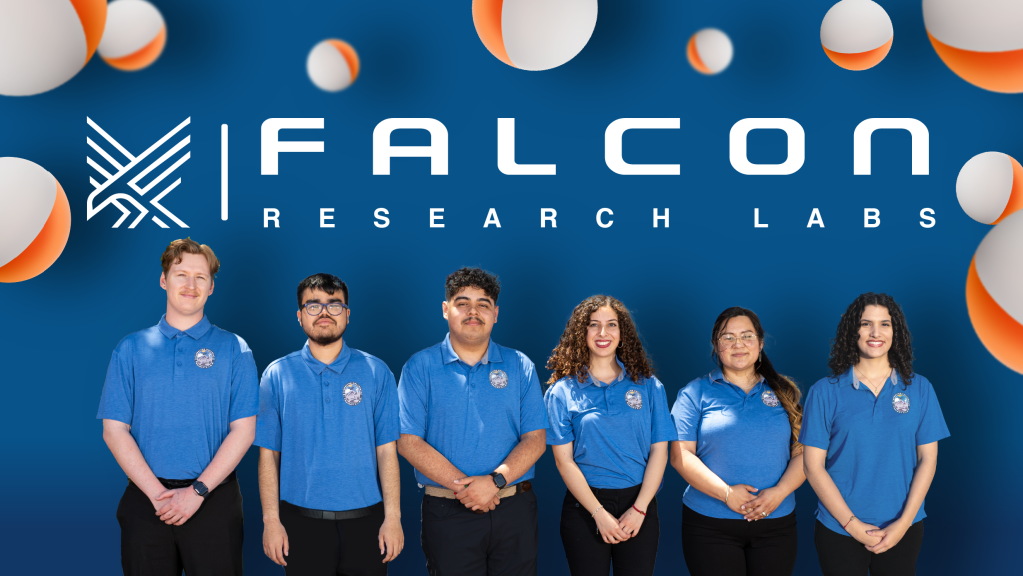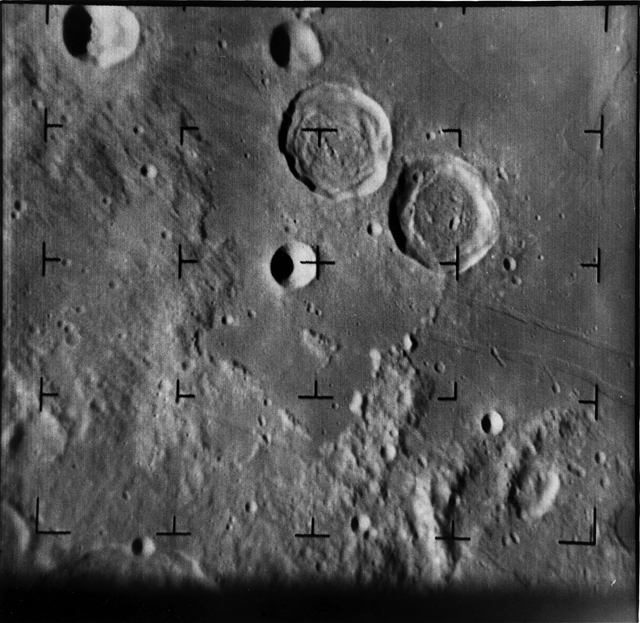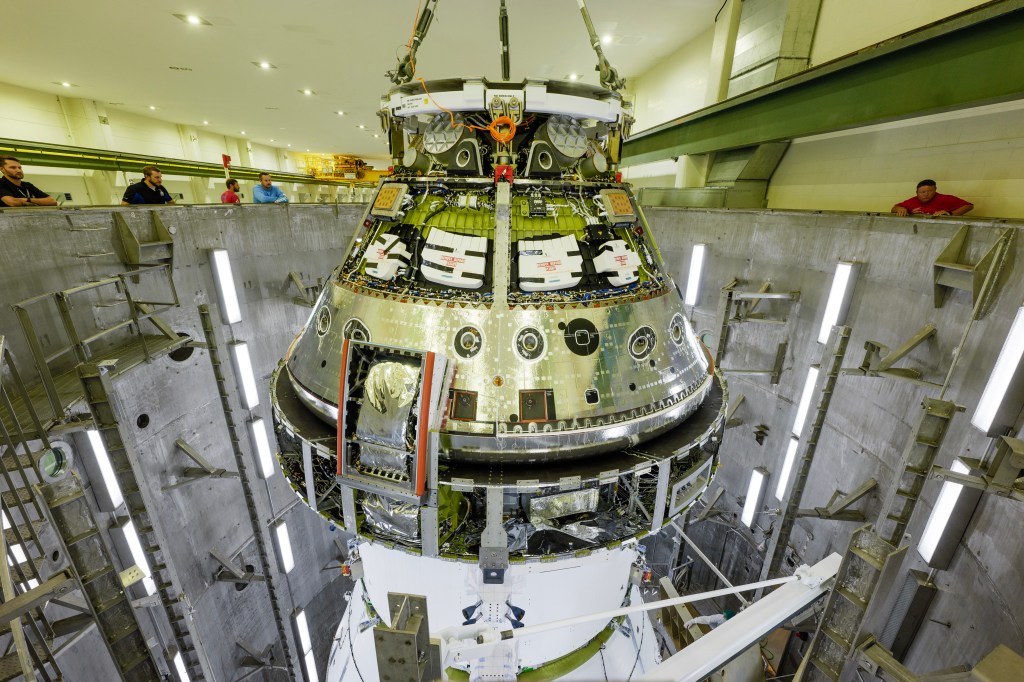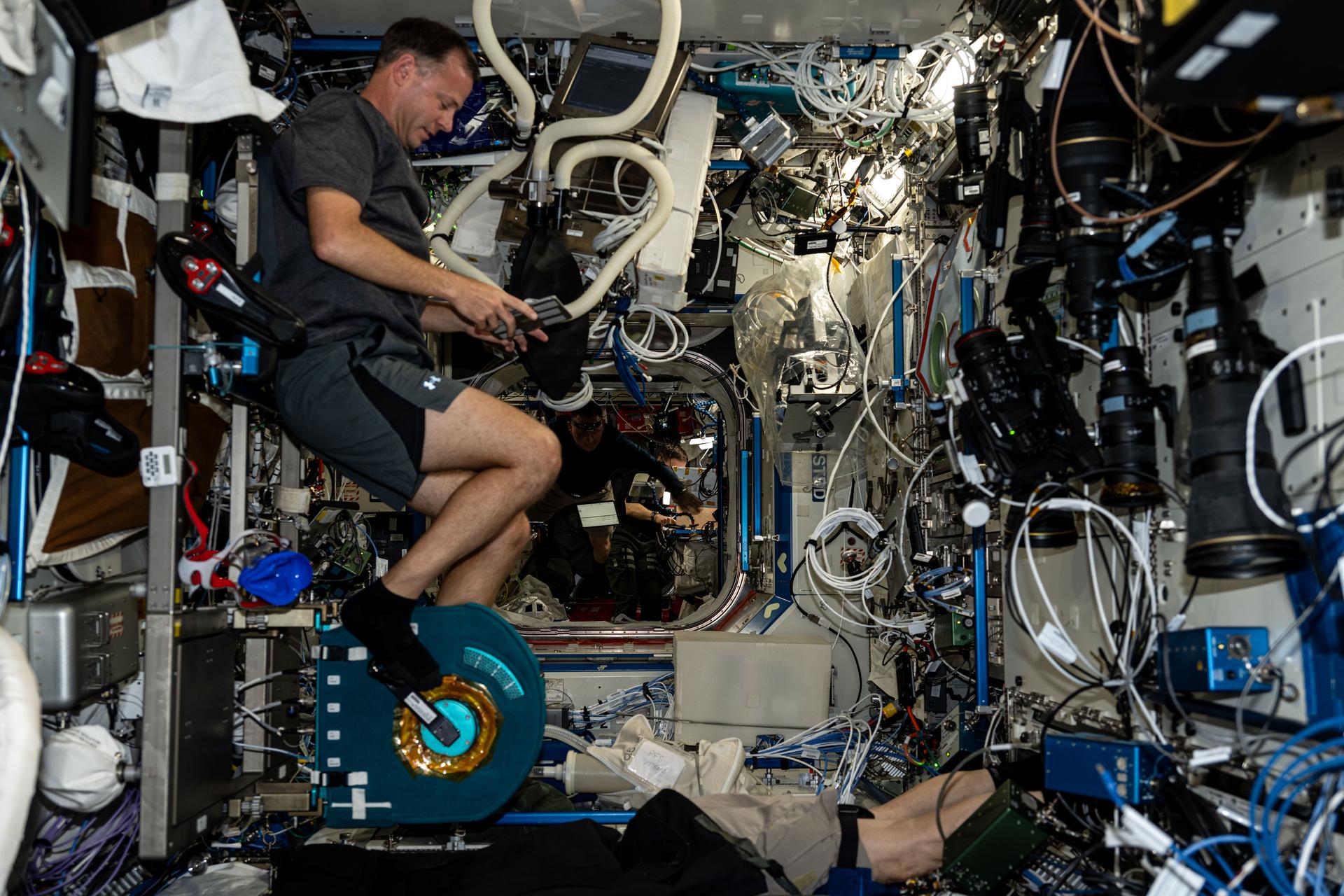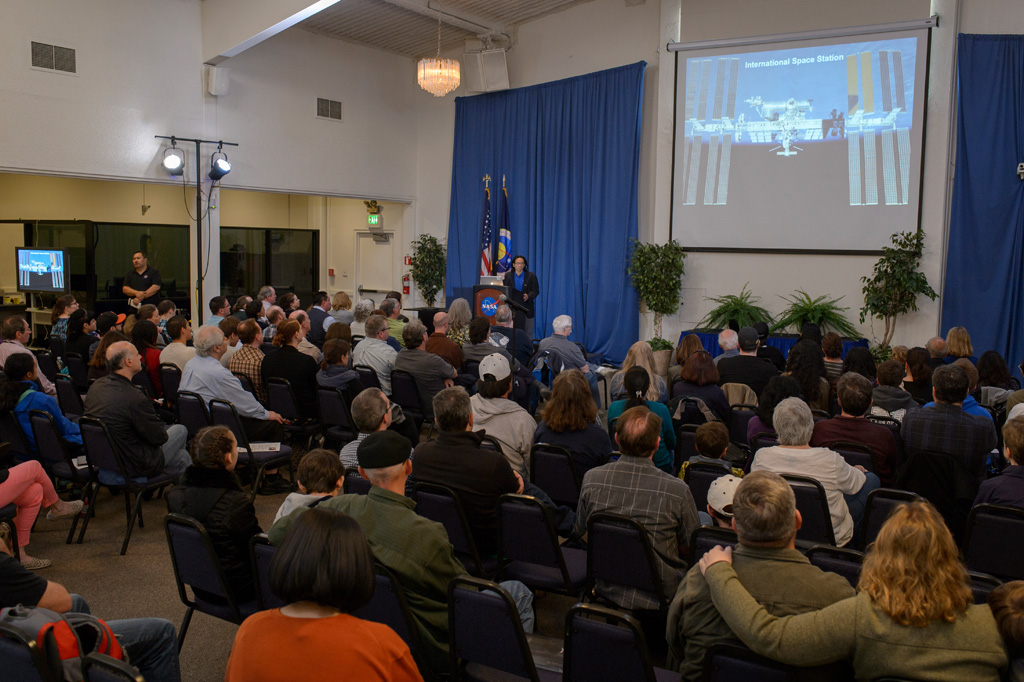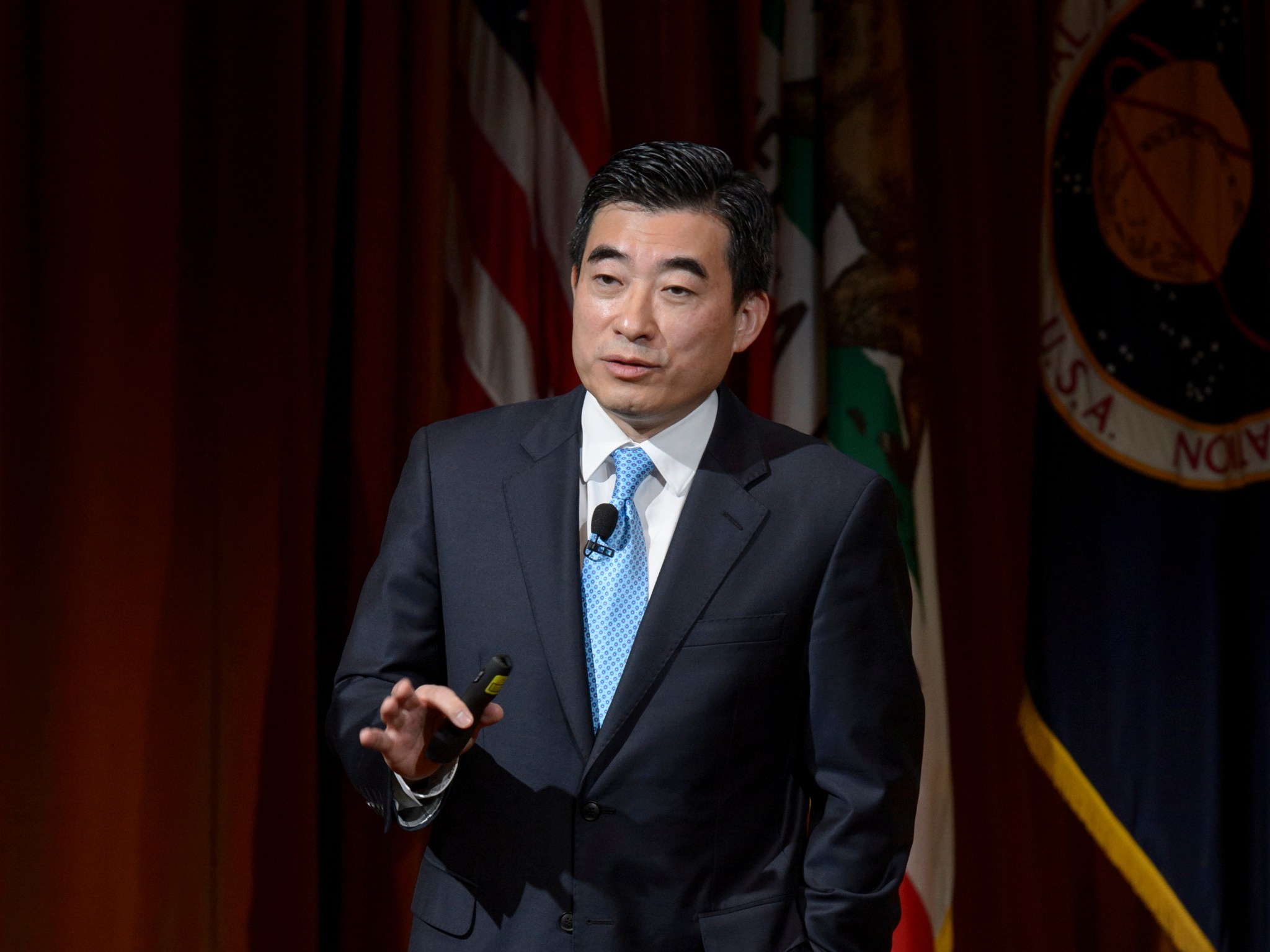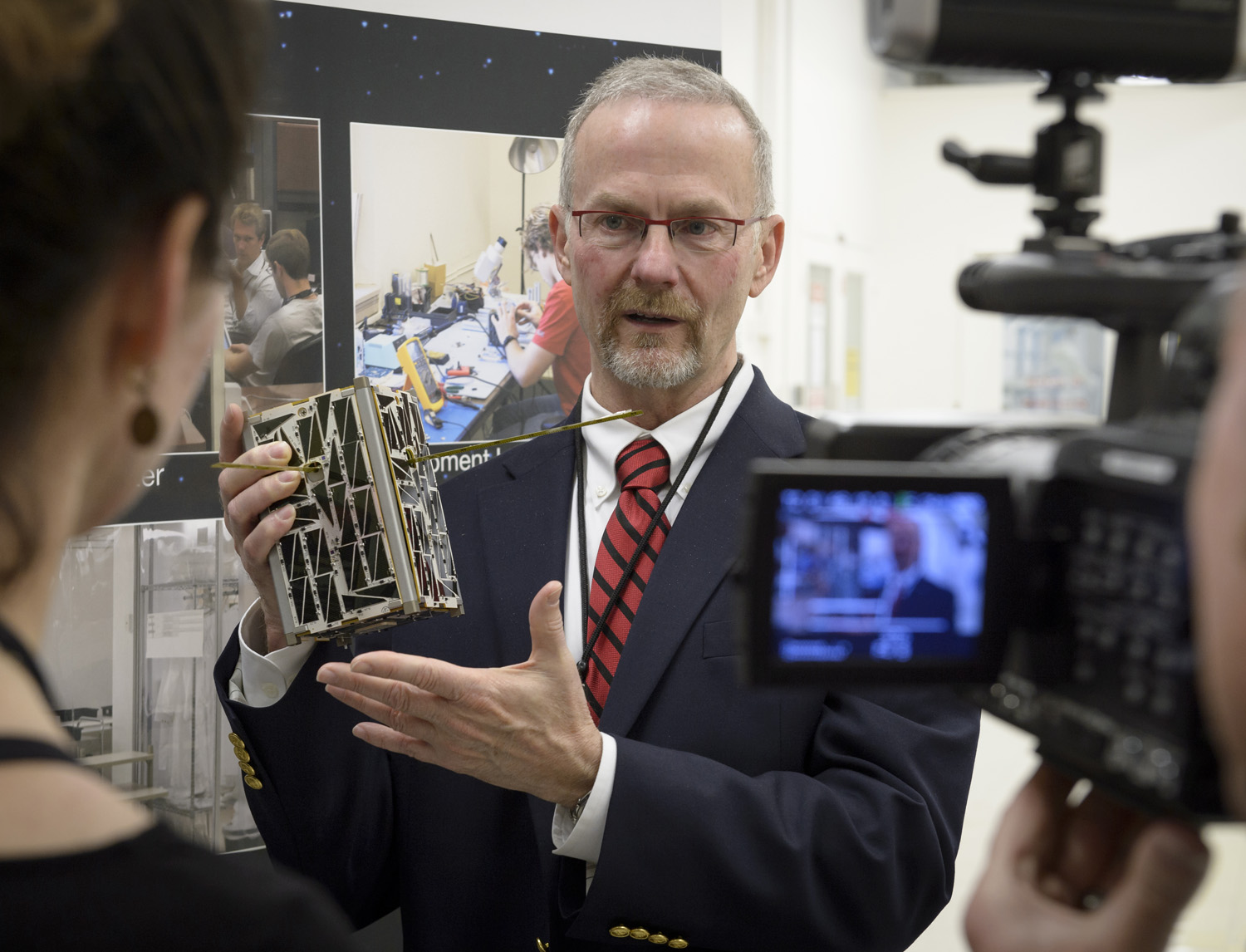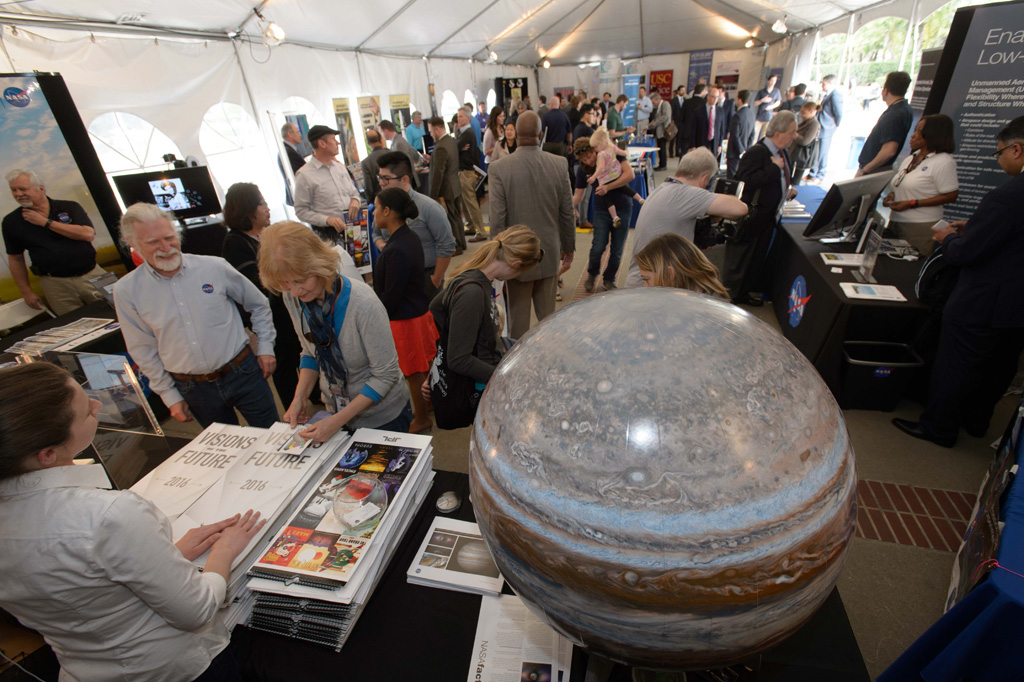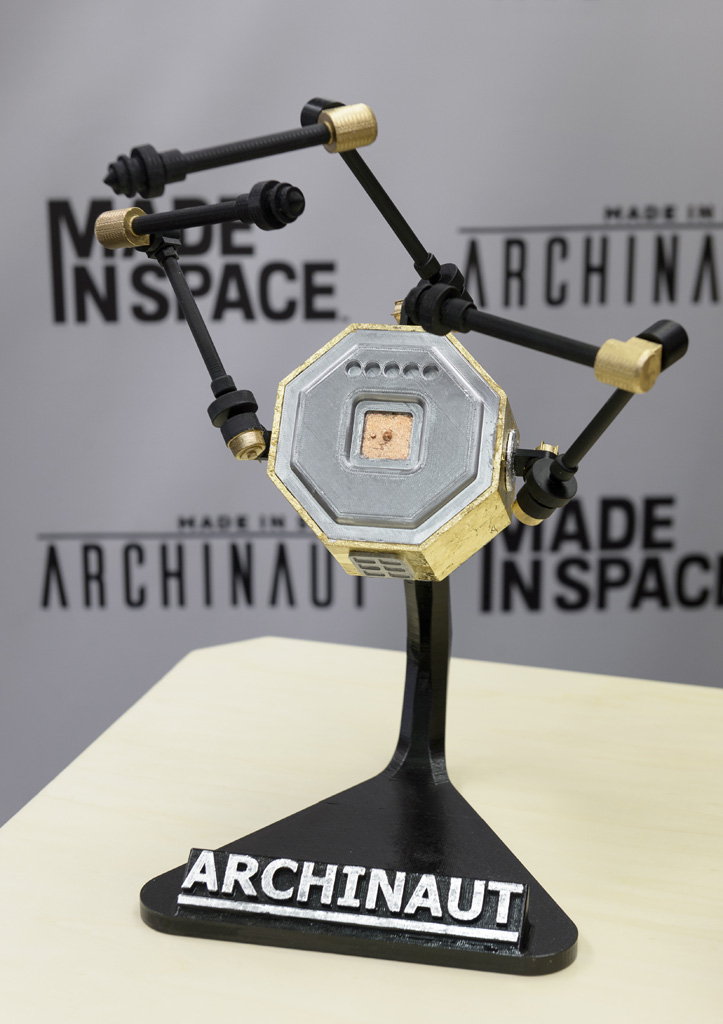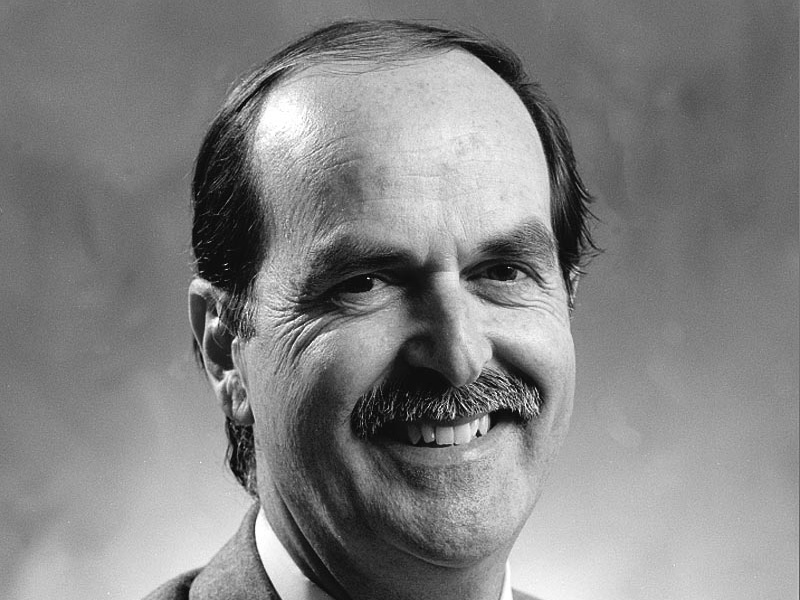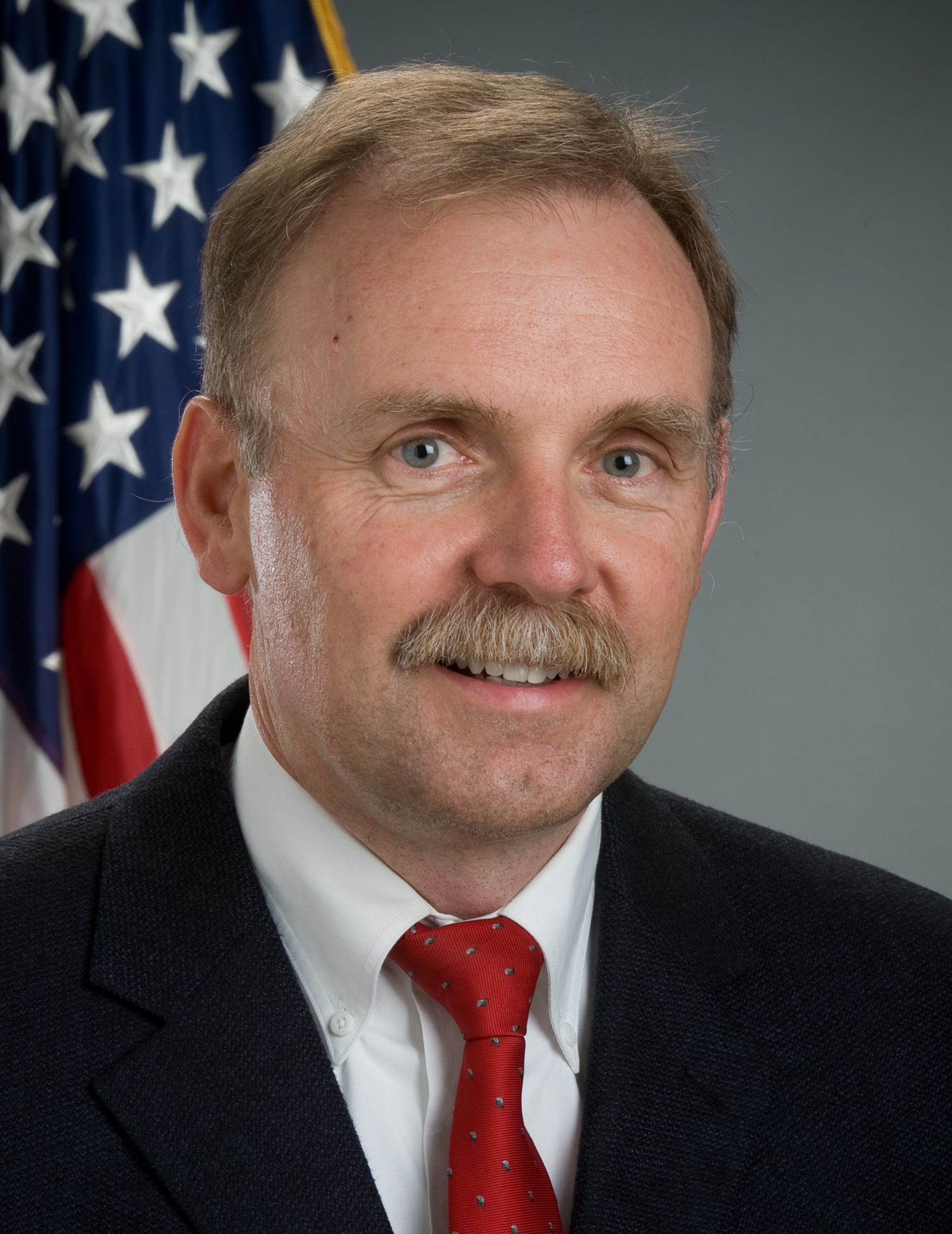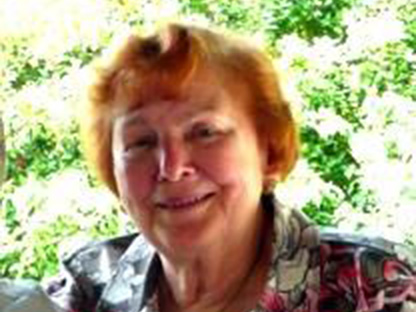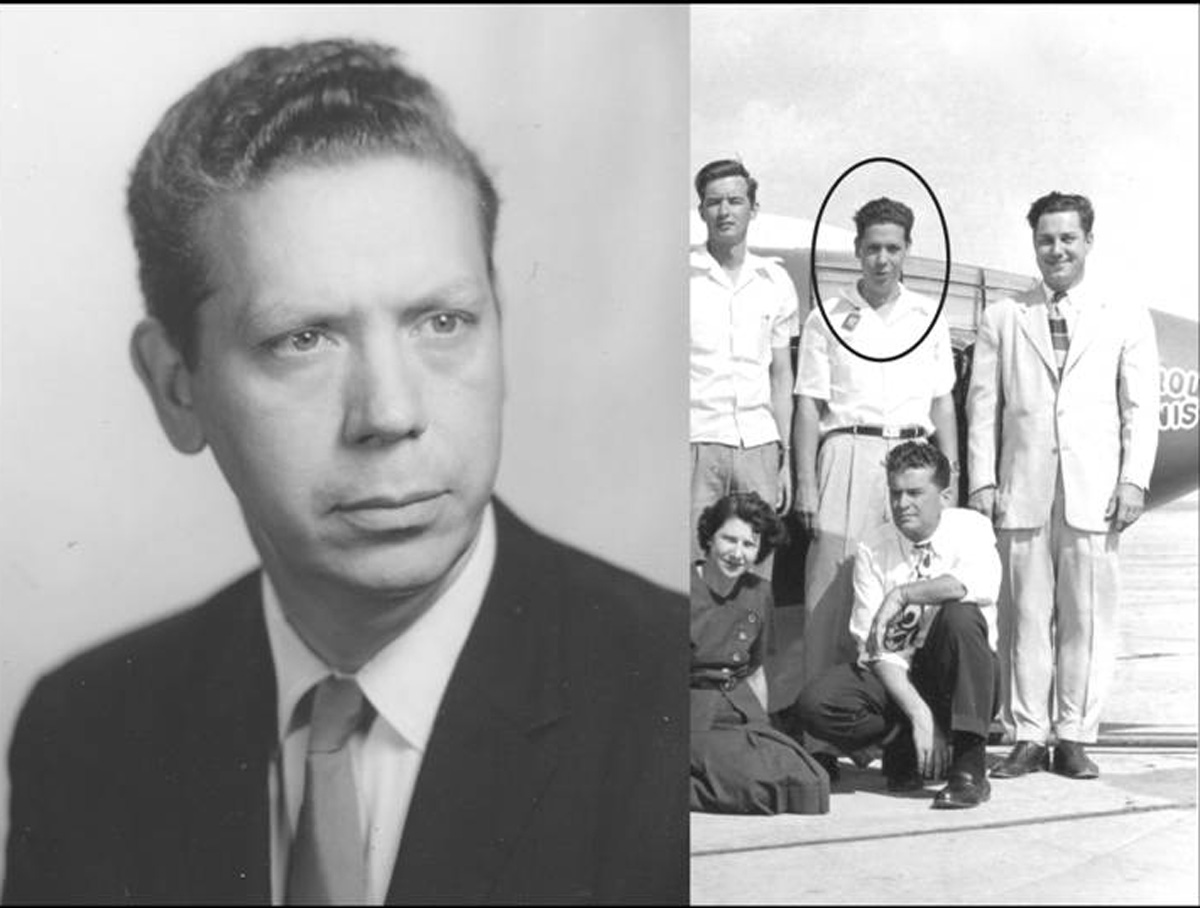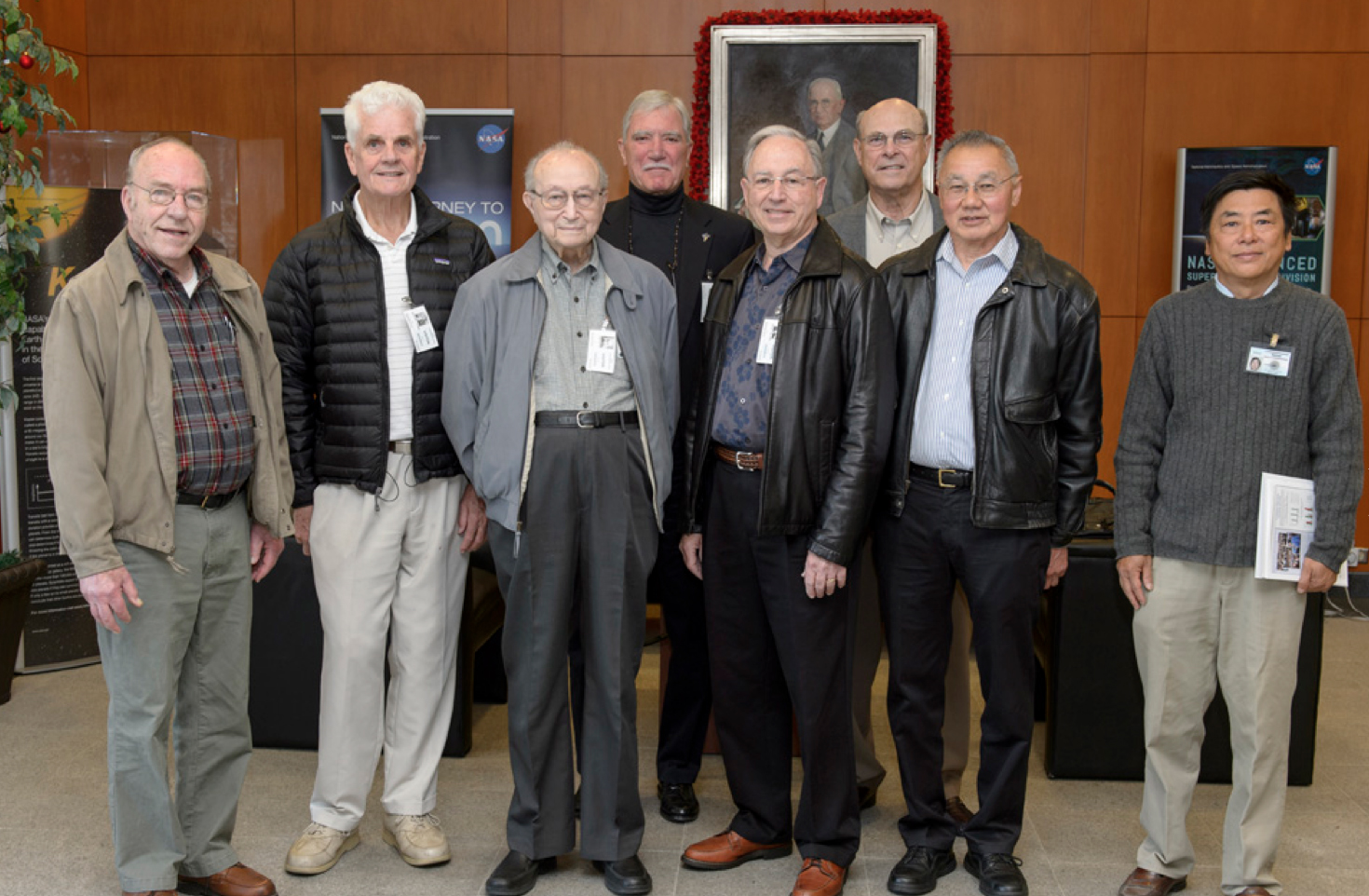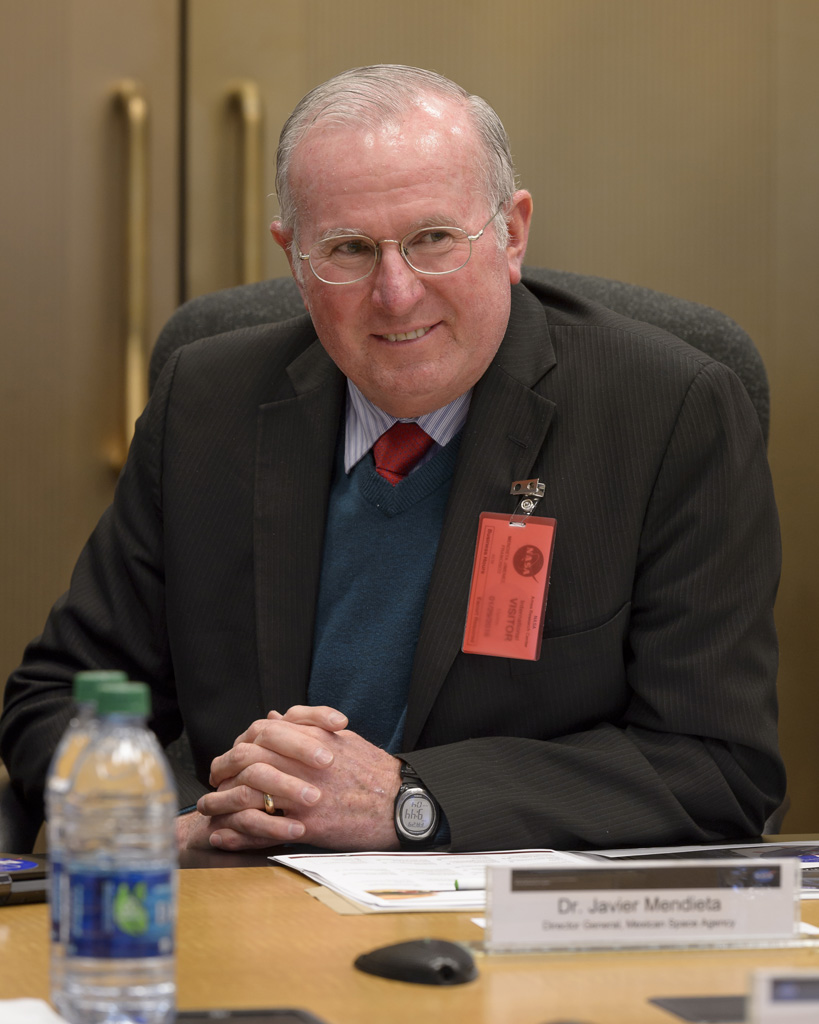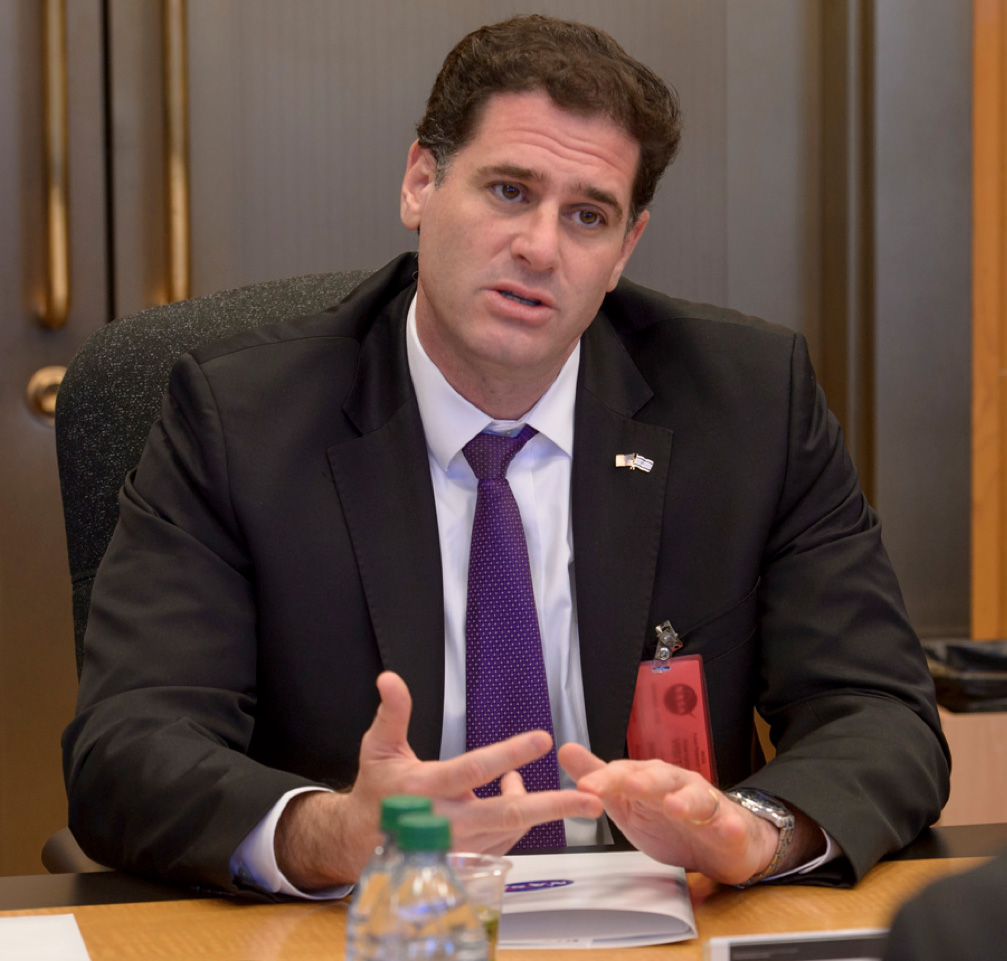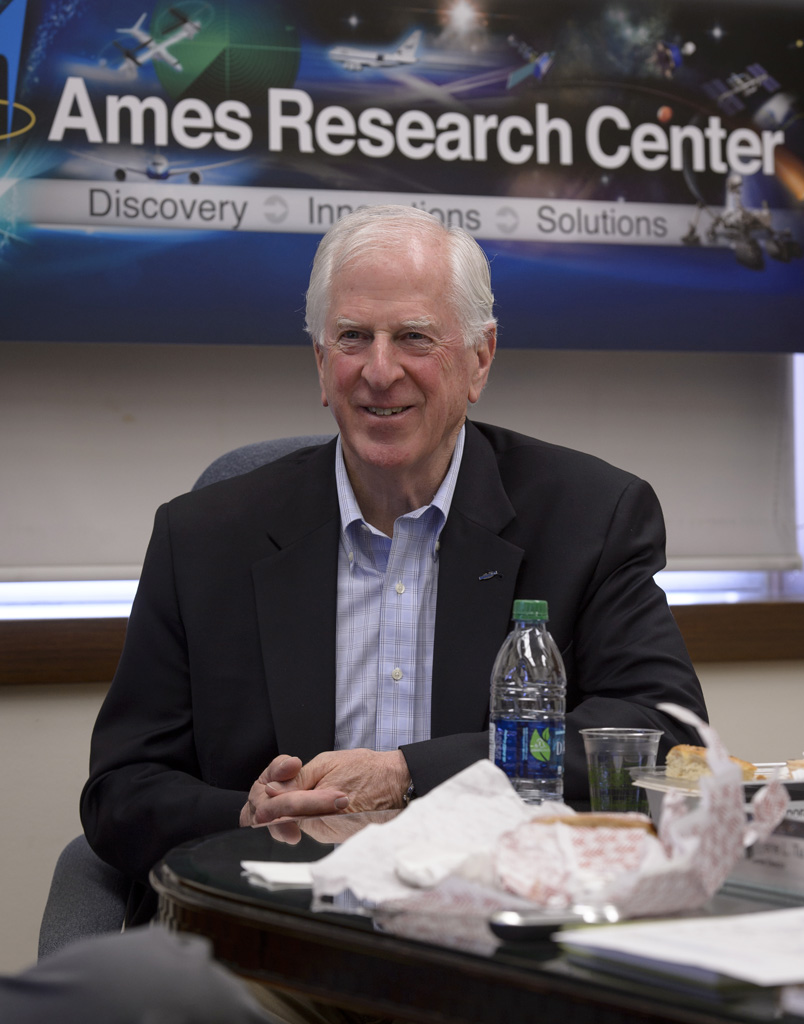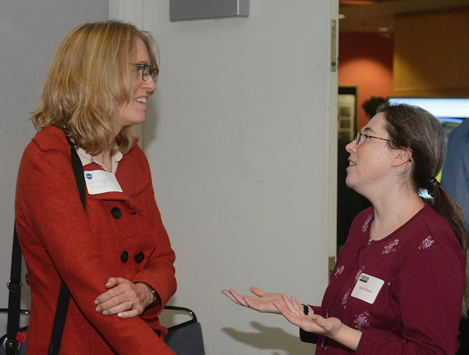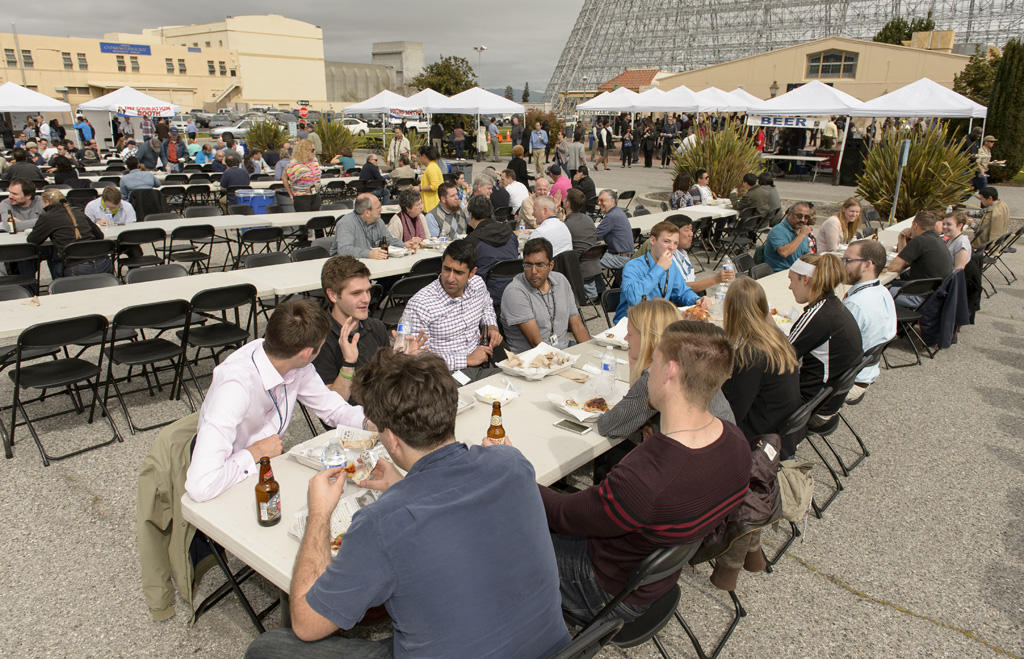NASA Ames Astrogram – Spring 2016
NASA Ames Astrogram – Spring 2016 (4MB PDF)
Ames hosts public viewing of successful CRS-8 launch
The eighth contracted mission with SpaceX under NASA’s Commercial Resupply Services (CRS) contract launched April 8, 2016, on a Falcon 9 rocket from Space Launch Complex 40 at Cape Canaveral Air Force Station (CCAFS) in Florida. The flight carried five Ames science payloads as well as other science research, crew supplies and hardware to the International Space Station (ISS) in support of the Expedition 47 and 48 crews.
The Ames Office of Education and Public Outreach hosted a public event in the Ames Training and Conference Center that highlighted the Ames science payloads that are being delivered to the ISS. The event featured a live NASA TV broadcast of the launch on a widescreen, an overview of the Center’s research on the ISS, presentations from Ames payload specialists and information booths on Ames bioscience research.
Ames life science experiments on CRS-8 included: Micro-9 a study of specific mechanisms of yeast cell signaling and response to microgravity; Micro-10, a study of the effects of spaceflight on the growth, gene expression and physiological responses of fungal cells; Microbial Tracking-1C, the third in a series of three studies that investigates the airborne and surface bound populations of microorganisms aboard the space station; Rodent Research-3, a commercial investigation that evaluates during spaceflight a countermeasure against muscle weakening; and the validation flight of Wetlab-2, a new system for conducting quantitative, real-time gene expression analysis aboard the ISS.
Data from some of the life science investigations will be shared with the scientific community via NASA’s open-access GeneLab data system.
Did the “man in the moon” look different from ancient Earth?
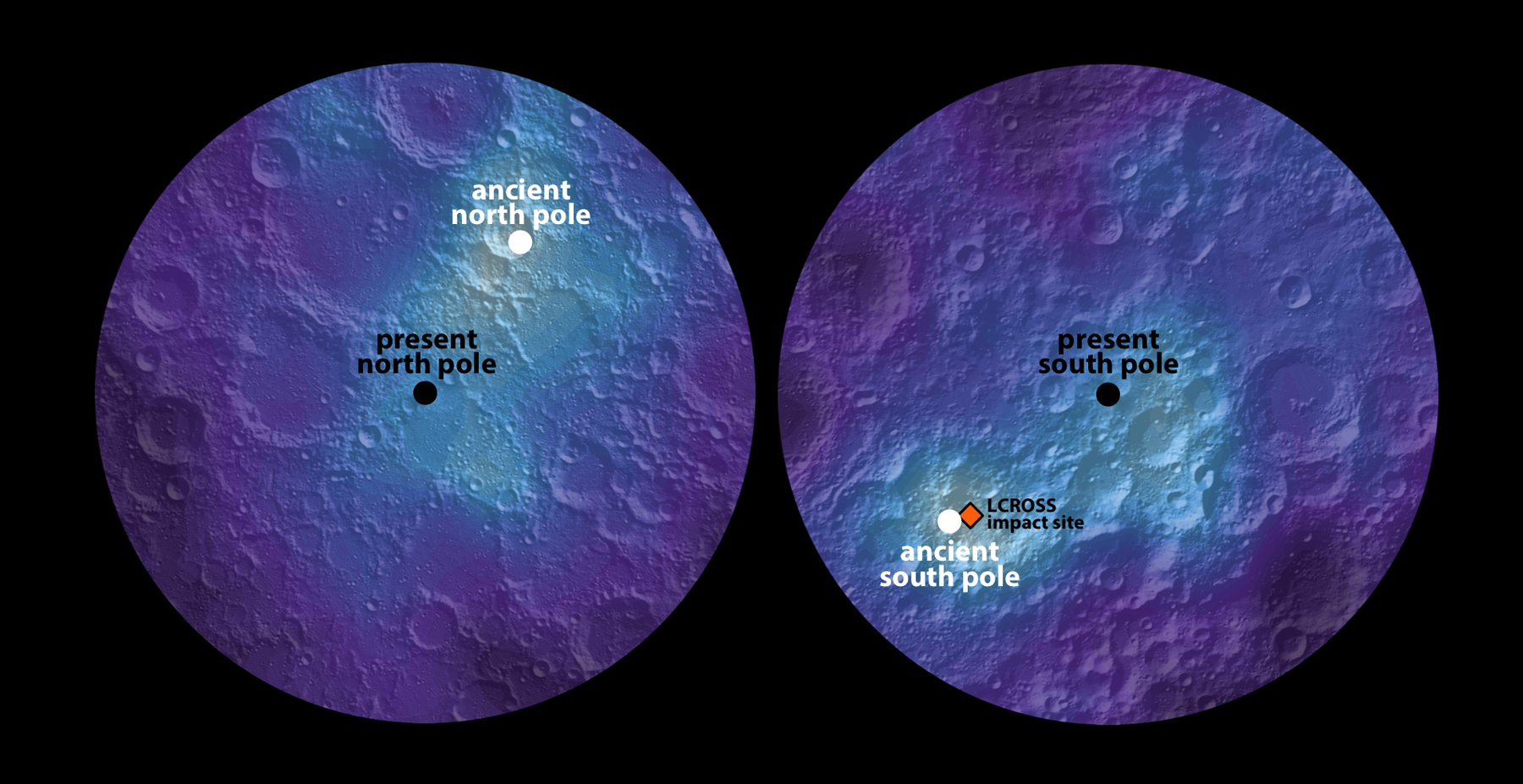
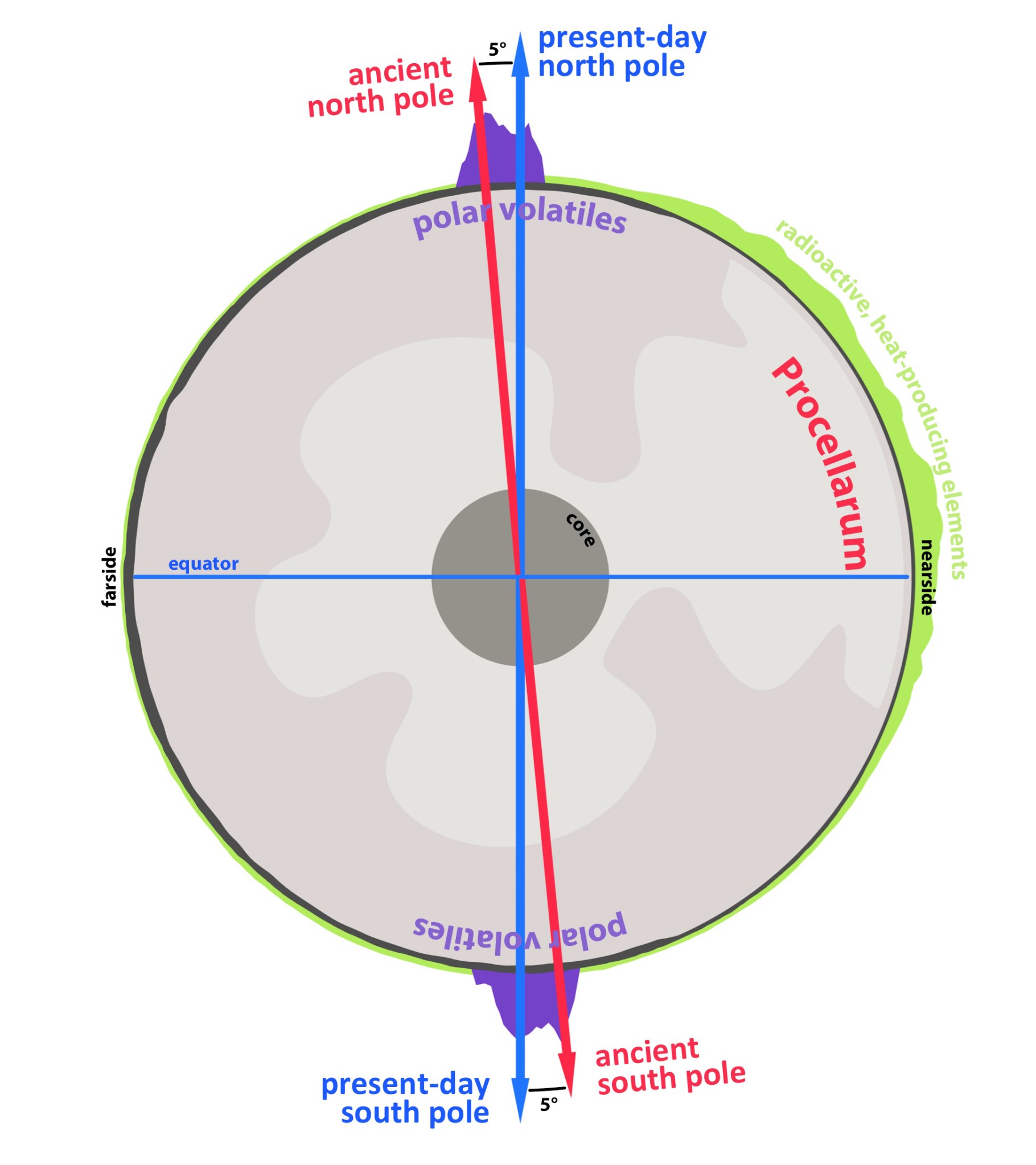
New NASA-funded research provides evidence that the spin axis of Earth’s moon shifted by about five degrees roughly three billion years ago. The evidence of this motion is recorded in the distribution of ancient lunar ice, evidence of delivery of water to the early solar system.
“The same face of the moon has not always pointed towards Earth,” said Matthew Siegler of the Planetary Science Institute in Tucson, Arizona, lead author of a paper in today’s journal Nature. “As the axis moved, so did the face of the ‘man in the moon.’ He sort of turned his nose up at the Earth.”
This interdisciplinary research was conducted across multiple institutions as part of NASA’s Solar System Exploration Research Virtual Institute (SSERVI) based at NASA Ames.
Water ice can exist on Earth’s moon in areas of permanent shadow. If ice on the moon is exposed to direct sunlight it evaporates into space. Authors of the Nature article show evidence that a shift of the lunar spin axis billions of years ago enabled sunlight to creep into areas that were once shadowed and likely previously contained ice.
The researchers found that the ice that survived this shift effectively “paints” a path along which the axis moved. They matched the path with models predicting where the ice could remain stable and inferred the moon’s axis had moved by approximately five degrees. This is the first physical evidence that the moon underwent such a dramatic change in orientation and implies that much of the polar ice on the moon is billions of years old.
“The new findings are a compelling view of the moon’s dynamic past,” said Dr. Yvonne Pendleton, director of SSERVI, which supports lunar and planetary science research to advance human exploration of the solar system through scientific discovery. “It is wonderful to see the results of several missions pointing to these insights.”
The authors analyzed data from several NASA missions, including Lunar Prospector, Lunar Reconnaissance Orbiter (LRO), Lunar Crater and Observation Sensing Satellite (LCROSS), and the Gravity Recovery and Interior Laboratory (GRAIL), to build the case for a change in the moon’s orientation. Topography from the Lunar Orbiter Laser Altimeter (LOLA) and thermal measurements from the Diviner lunar radiometer – both on LRO – are used to aid the interpretation of Lunar Prospector neutron data that support the polar wander hypothesis.
Siegler noticed that the distribution of ice observed at each of the lunar poles appeared to be more related to each other than previously thought. Upon further investigation, Siegler – and co-author Richard Miller of the University of Alabama at Huntsville – discovered that ice concentrations were displaced from each pole by the same distance, but in exactly opposite directions, suggesting the spin axis in the past was tilted from what we see today. A change in the tilt means that some of the ice deposited long ago has since evaporated as it was exposed to sunlight, but those areas that remain in permanent shadow between the old orientation and the new one retain their ice, and thus indicate what happened.
A planetary body can shift on its axis when there is a very large change in mass distribution. Co-author James Keane, of the University of Arizona in Tucson, modeled the way changes in the lunar interior would have affected the moon’s spin and tilt. In doing so, he found the Procellarum region on the lunar near-side was the only feature that could match the direction and amount of change in the axis indicated by the ice distributions near the poles. Furthermore, concentrations of radioactive material in the Procellarum region are sufficient to have heated a portion of the lunar mantle, causing a density change significant enough to reorient the moon.
Some of this heated mantle material melted and came to the surface to form the visible dark patches that fill large lunar basins known as mare. It’s these mare patches that give the man in the moon his “face.”
Siegler, Miller, and co-author David Lawrence of Johns Hopkins Applied Physics Laboratory in Laurel, Maryland are part of the Volatiles, Regolith and Thermal Investigations Consortium for Exploration and Science team, one of nine teams funded by SSERVI.
Said Siegler, “These findings may open the door to further discoveries on the interior evolution of the moon, as well as the origin of water on the moon and early Earth.”
For more information about SSERVI and the finding, visit: http://sservi.nasa.gov
NASA marks successful drone traffic management test
In the first and largest demonstration of its kind, NASA and operators from the Federal Aviation Administration’s (FAA) unmanned aircraft systems (UAS) test sites across the country flew 22 drones simultaneously to assess rural operations of NASA’s UAS traffic management (UTM) research platform.
Operators outside NASA interacted with the UTM research platform, entering flight plans and planned operations from several geographically diverse locations, using various aircraft and software. The UTM research platform checked for conflicts, approved or rejected the flight plans and notified users of constraints. Engineers at NASA Ames monitored operations and system load and gathered qualitative feedback to identify capability gaps to further refine the UTM research.
“We didn’t have any testing problems today,” said Parimal Kopardekar, manager of NASA’s Safe Autonomous Systems Operations project and lead of NASA’s UTM efforts. “NASA extensively tested Technical Capability Level one and worked very closely with the FAA test sites, and the UTM research platform performed well. This test would not have been possible without the six FAA test sites – it was a collaborative effort to ensure a successful test.”
A total of 24 drones flew multiple times throughout the three-hour test, with 22 flying simultaneously at one point. The mission was declared successful, given the minimum success criteria of 16 simultaneous operations was achieved. In addition to the live aircraft interacting with UTM, NASA Ames introduced dozens of virtual aircraft into the same airspace to further enhance the test. This mixing of live flights with virtual flights provided additional insight for future tests to refine the UTM concept.
Conducting a successful test required hours of coordination and logistics. Weather conditions at each of the test sites provided an additional challenge as drones cannot fly in rain or high winds, so engineers monitored weather conditions across the country to ensure the drones could fly. Winds are often greater in the afternoon, so the optimum flight window was 7 a.m. – 3 p.m. PDT. The forecast the prior day predicted a 40 percent chance of rain for two locations, but the weather cooperated, and all sites – Fairbanks, Alaska; Grand Forks, North Dakota; Reno, Nevada; Rome, New York; Virginia Tech’s locations in Blacksburg, Virginia, and Bushwood, Maryland; and Corpus Christi, Texas – flew during the test.
“After so much preparation and practice, it was very rewarding to see all test sites have success with weather, platforms and connectivity,” said Tony Basile, director of operations at NUAIR and New York test site manager. “It was additionally rewarding to hear from NASA that today’s efforts were successful on their end as well.”
Joseph Rios, flight test director and UTM technical lead explained, “NASA built the research platform and tested it on a local scale, but we needed the experience and expertise at each of the FAA test sites to exercise the platform in this geographically diverse way. Their efforts and skills in managing field deployments were pivotal to the success of this activity.”
Echoing that sentiment, Cathy Cahill, the director of the Alaska Center for Unmanned Aircraft Systems Integration in Fairbanks, said, “This mission demonstrated the technological advances that can be made when the expertise of NASA is combined with the capabilities of our nation’s UAS test sites.”
“We enjoyed working with the NASA UTM team to explore UAS air traffic management concepts through the UTM research platform,” said Richard C. Kelley, chief engineer for the Nevada Advanced Autonomous Systems Innovation Center at the University of Nevada, Reno. “The software performed wonderfully, providing much-needed data and pointing toward open questions for the research community to address as we work to safely integrate unmanned aircraft into the National Airspace System.”
Each FAA test site determined how they wanted to interact with NASA’s UTM research platform. For example, the Northern Plains UAS test site from the North Dakota Department of Commerce used fixed wing aircraft from four different manufacturers, two of which built UTM software capabilities into their own ground control stations, while the other two used UTM software in their aircraft.
“We wanted to test UTM concepts across diverse implementation methods, and partnering with a number of local and regional companies was a key factor in our ability to do so, and our success today,” said Doug Olsen, principal investigator of the project at the University of North Dakota.
Many of the operators and test site employees remarked on the potential benefits of future systems that may leverage the results of this work.
“Using a traffic management framework to separate the aircraft and provide position awareness to air traffic control or to a mission commander helps us provide space between manned aircraft and unmanned aircraft, and actually promotes the safety of integrating those two into the airspace,” said Mathew Nelson, a UAS pilot at the Texas FAA test site.
“NASA is developing forward-thinking solutions to today’s aeronautical challenges with UAS,” said Rose Mooney, executive director of the Virginia Tech Mid-Atlantic Aviation Partnership.
UTM is still in the early research stages. This test of UTM Technical Capability Level one addressed rural UAS operations within line-of-site, such as could be potentially used for applications for agriculture, firefighting and power line monitoring. The UTM project has four technical capability levels, each increasing in complexity, culminating with level four – with potential applicability for high-density urban UAS operations. NASA is working closely with the FAA throughout the research process to define deliverables. NASA plans to turn over its UTM research to the FAA in 2019 for further testing.
This activity is sponsored by the Airspace Operations and Safety Program under NASA’s Aeronautics Research Mission Directorate. Four of NASA’s research centers – Ames, NASA’s Armstrong Flight Research Center in Edwards, California; Glenn Research Center in Cleveland; and Langley Research Center in Hampton, Virginia – are actively involved in the agency’s UTM initiative.
Pleiades helps explain NASA’s IRIS Solar Observatory findings
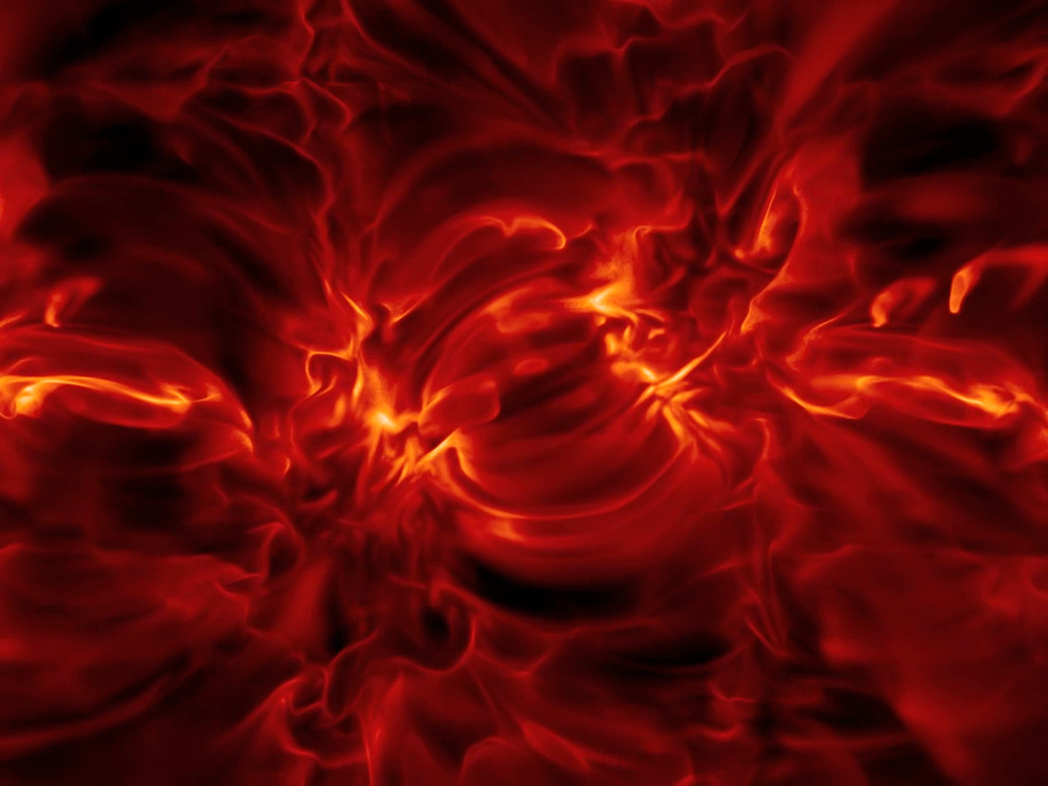
Researchers around the world are studying the sun to better understand its formation, evolution and impact on Earth. To help explain longstanding mysteries of the sun’s atmosphere, scientists turned to one of the world’s fastest supercomputers, Pleiades, located at the NASA Advanced Supercomputing (NAS) facility, at NASA Ames.
The sun’s plasma, a superheated mix of charged particles, flows and creates magnetic fields, that move through the surface and extend throughout the solar atmosphere. The synthetic image is derived from numerical simulations that reveal how the sun’s magnetic field structures its atmosphere on fine scales.
Using images from IRIS, astrophysicists are producing simulations that may help explain how the outer solar atmosphere is shaped and heated. By combining numerical modeling with direct observation, the researchers are learning how magnetic fields generated in the sun’s interior affect its lower atmosphere, or chromosphere, which is the source of the ultraviolet radiation that reaches Earth.
For more information about the modeling and simulation work done on Pleiades and to view the simulation video, visit: http://www.nas.nasa.gov/publications/articles/feature_IRIS_Carlsson.html
AAAG hosts skit “Unsung Heroes” honoring Black History Month
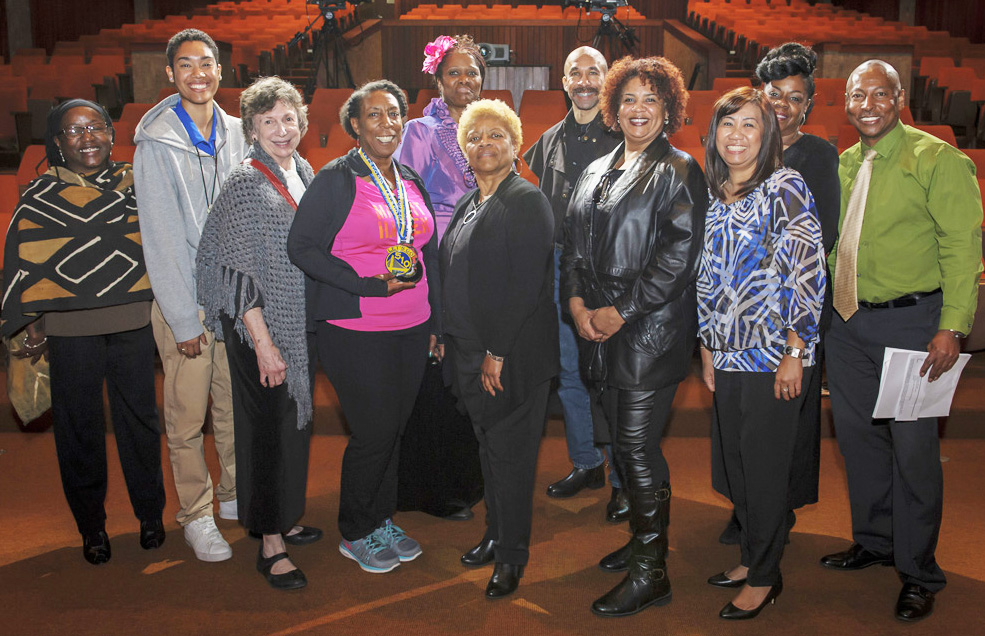
The Ames African-American Advisory Group (AAAG) performed a skit in honor of Black History Month, entitled “Unsung Heroes.” February 1 marked the beginning of Black History Month and it is not only a time when people of African ancestry come together in memory of their rich past and learn about the many contributions and accomplishments made to our nation’s history, but allows every American the opportunity to celebrate the traditions of African Americans and those aspects of their own culture and positive contributions made to society.
Black History Month originally began as Negro History Week in 1926. It took place during the second week of February because it coincided with the birth dates of Frederick Douglass and Abraham Lincoln. Harvard-trained historian, Carter G. Woodson, is credited with the creation of Negro History Week. In 1976, the bicentennial of the United States, President Gerald R. Ford expanded the week into a full month. He said, “Our country needed to seize the opportunity to honor the too-often neglected accomplishments of black Americans in every area of endeavor throughout our history.”
There is no American history without recognizing the contributions made by countless African Americans who carved a thumb print into the history of this country. We commemorate and celebrate all cultures that have contributed to our nation’s history.
Shin provides ARMD budget
Warmbrodt recognized for advancing vertical flight aeronautics
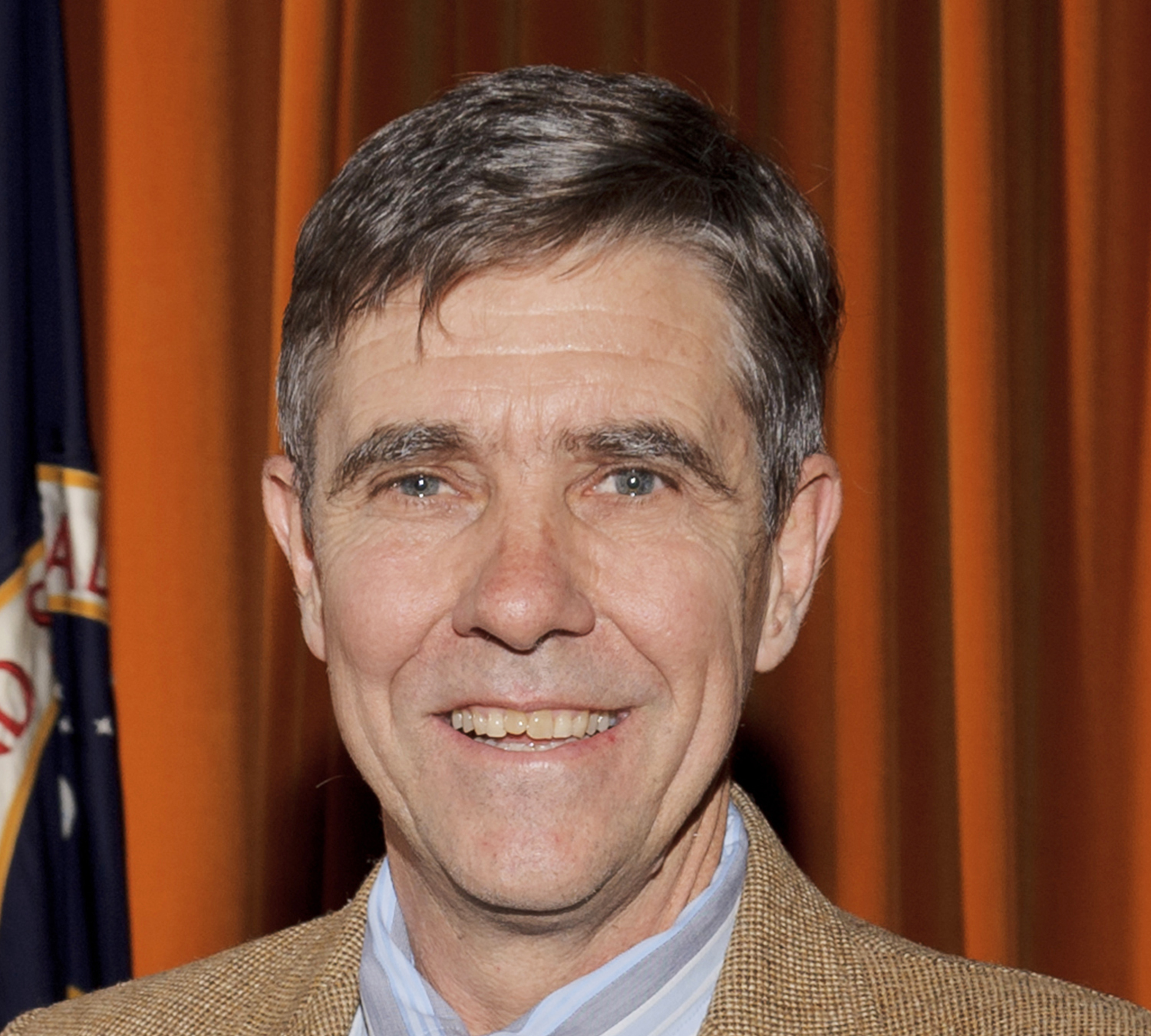
Media converse with small satellite experts, tour labs
On March 8, 2016, members of the news media came out to Ames Research Center to learn about NASA’s small spacecraft technology development and upcoming launches, and to tour assembly and testing facilities.
NASA leadership, scientists and engineers involved in small spacecraft technology explained the growing importance of small spacecraft in space exploration, shared milestone accomplishments and discussed the series of NASA-funded technology demonstration missions set to launch this year.
These cost-effective small spacecraft missions provide opportunities for NASA to perform high-value science using advanced technologies and innovative approaches to spacecraft engineering. Also, they are designed to push the boundaries of space-to-Earth communications for CubeSats, test satellite-to-satellite communications and demonstrate the small spacecraft autonomous movement capabilities.
The panelists included Andrew Petro, program executive, Small Spacecraft Technology Program at NASA Headquarters in Washington, D.C.; Roger Hunter, program manager, Small Spacecraft Technology Program at Ames; Ehson Mosleh, vice president of Systems & Mission Assurance for the CubeSat Proximity Operations Demonstration (CPOD) project at Tyvak Nano-Satellite Systems, Inc. in Irvine, California; Richard Hodges, principal investigator for the Integrated Solar Array and Reflecterray Antenna (ISARA) at the Jet Propulsion Laboratory in Pasadena, California; and Richard Welle, principal investigator for the Optical Communications and Sensor Demonstration (OCSD) project and director of the Microsatellite Systems department at The Aerospace Corporation, in El Segundo, California.
After the panel briefing, media toured assembly laboratories and test facilities as well as the Multi-Mission Operations Center, where engineers track and facilitate the operation of the spacecraft and payloads. The tour also included visits to laboratories for the Eu:CROPIS and BioSentinel projects, which both support science missions managed by Ames.
The previously launched Nodes satellites are scheduled to deploy in mid-May 2016 from the International Space Station, to demonstrate swarm communications. In addition to Nodes mission, the ISARA, OCSD and CPOD projects are funded by the Small Spacecraft Technology Program, managed by Ames, within NASA’s Space Technology Mission Directorate.
For more information about NASA’s Small Spacecraft Technology Program, visit: https://www.nasa.gov/smallsats
NASA participates in 5th Annual California Aerospace Days
Three NASA Centers participated in the American Institute of Aeronautics and Astronautics (AIAA) 5th Annual California Aerospace Week in Sacramento, California, Feb. 29 – March 1, 2016. The event featured panels, exhibits hearings and discussions highlighting the importance of aerospace.
Dr. Eugene Tu, Ames center director; Lt. Gen. Larry James, deputy director of the Jet Propulsion Laboratory and David McBride, director of NASA’s Armstrong Flight Research Center met with Governor Jerry Brown to discuss the Agency and its wide range of aerospace work in California.
Parimal Kopardekar, manager of NASA’s Safe Autonomous Systems Operations project and principal investigator of NASA’s UTM efforts briefed the legislature about the challenges of integrating Unmanned Aerial Vehicles in the national airspace
NASA representatives from Ames, Armstrong and JPL engaged approximately 1,000 visitors from area schools and the state legislature. The public viewed displays of aeronautics, satellites and solar system exploration on the grounds of the State Capitol.
Ames highlighted next generation air traffic management initiative ATD2 and UTM drone traffic management system, and several small satellites including SPHERES.
NASA, Made In Space Inc’s media day introduces new space technology
On Feb. 19, 2016, local reporters attended a media day at Made In Space, Inc. (MIS), on the campus of NASA’s Research Park to learn about the startup company’s recent proposal award as part of NASA’s “Utilizing Public-Private Partnerships to Advance Tipping Point Technologies” solicitation, issued through NASA’s Space Technology Mission Directorate (STMD).
Steve Jurczyk, associate administrator for STMD, spoke of the importance of the solicitation and media were given a tour of the MIS facilities. The two-hour event included informal briefings with MIS leadership and a discussion on their winning proposal.
The American-based company was the first to use a 3-D printer on the International Space Station. Its project, “Versatile In-Space Robotic Precision Manufacturing and Assembly System,” was one of nine selected by STMD to mature technologies beyond their “tipping point.” The goal of their selection is to develop mature technologies and qualify them for market, stimulating the commercial space industry while delivering technologies and capabilities needed for future NASA missions and commercial applications.
The MIS proposed technology, called Archinaut, enables a wide range of in-space manufacturing and assembly capabilities by combining space-proven robotic manipulation with additive manufacturing technologies demonstrated on ISS.
MIS leveraged NASA’s Small Business Innovation Research (SBIR) program, in which they received a Phase I and subsequent Phase II award. Their 3-D printer’s success was a result of the SBIR program.
For more information about NASA’s STMD, visit: https://www.nasa.gov/spacetech
Bolden, Honda tour Ames, present Jin-Woo Han with PECASE Award
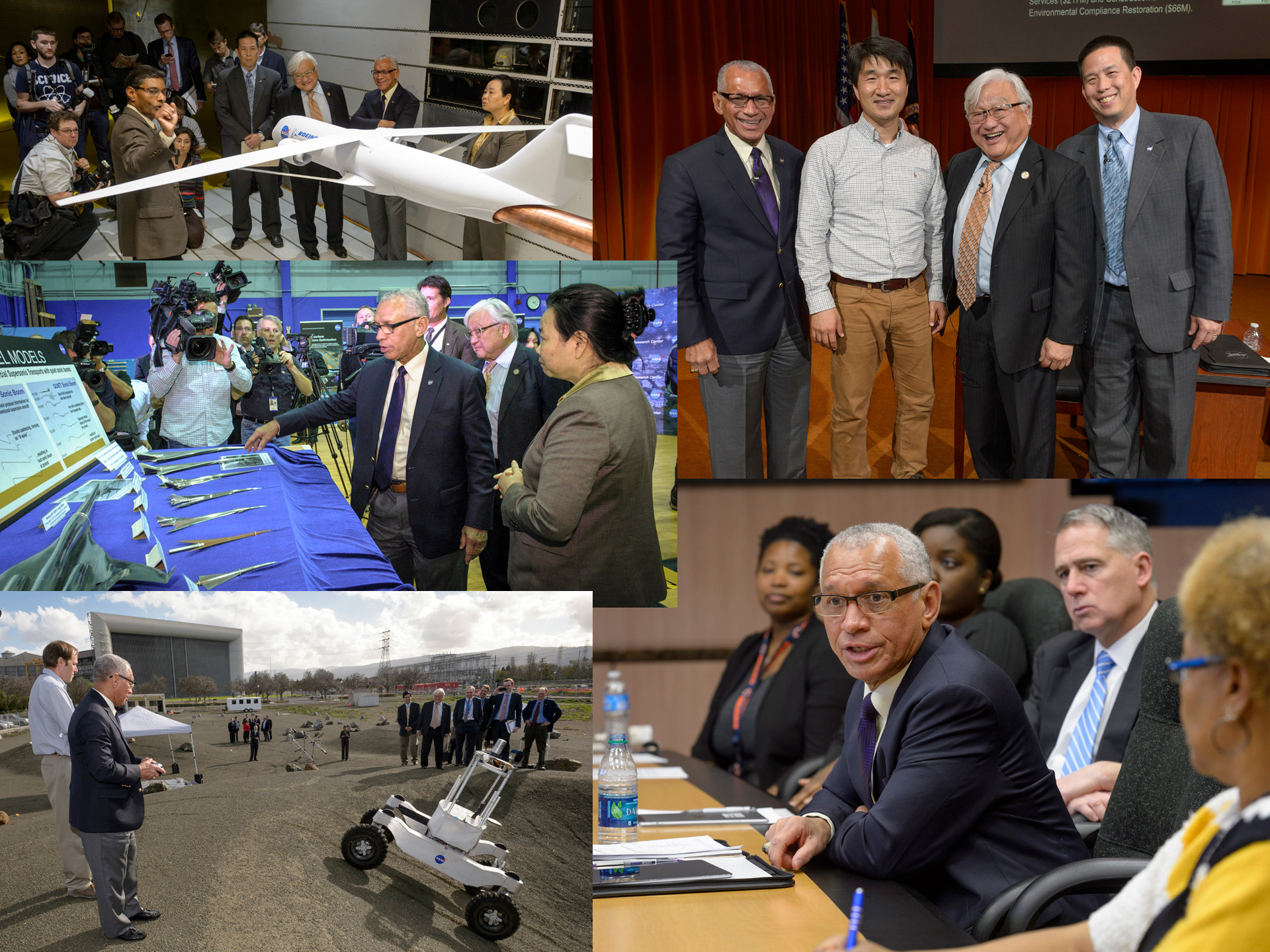
Former NASA engineer makes millions with STEMBoard
For Aisha Bowe, CEO and co-founder of STEMBoard and former aerospace engineer at NASA Ames, starting a tech company in Silicon Valley was a no go. “We went to the Valley to raise money and the reception wasn’t what we had hoped for, so we decided we knew what we wanted to do and that we were going to make it work. So I continued to work at NASA for two years until we got the company off the ground,” says Bowe.
The resilience paid off for the co-founders of the innovative tech company who partner with defense and enterprise clients to create smart systems and software solutions. “I’m so happy that we didn’t raise a single dime. I run a profitable, sustainable company that I own 51% of outright without any significant debt,” says Bowe.
Bowe states she remembered being aware that technology was changing very rapidly, but not necessarily thinking she wanted to be part of that shift. “When I was in community college, I realized that I had an aptitude for math and I became interested in space and exploration while reading science fiction and novels about deep space, satellites and spaceships.” Interestingly NASA has a tagline, “We turn science fiction into fact.” “So I was seeing all of this and when the idea presented itself to choose the path of aerospace engineer, I knew it was something that I would always be excited about.
The idea that we’ve perfect
ed cruising at 35,000 plus feet in a pressurized tube boggles my mind. It’s safer than driving. And you now have WiFi and you have TV, and it’s amazing when you think about what went into creating that.”
Bowe states she was fortunate to be in a program that combined one’s undergraduate and graduate studies. There was a professor, Thomas Zurbuchen, who had an instrument with NASA called Mercury Messenger. The director of Engineering at NASA at the time came to visit her professor and he asked her to take him on a tour of the campus.
“When I met the director, it was one of those moments where you know it is meant to be. He asked me why I didn’t submit my resume, and I realized at that moment that I didn’t think I was good enough. He said “let me be the judge of that” and I submitted my resume. Within two weeks, I was offered a position in the intern program.”
“At that point, I realized I needed to redefine how I think about myself and what’s possible for me, so I started setting really ambitious goals. I want to be a distinguished employee. I want to do this with public service. I want to do this with technology and outreach.So I published papers. I spoke to school groups. I was a recipient of NASA’s Equal Opportunity and Diversity Medal, which is one of NASA’s highest honors given to individuals within government who are champions of diversity and inclusion programs or display those characteristics within the workplace.
I was part of the African-American advisory group. I created a career shadowing program for students. There are so many talented people out there but they don’t have the access and exposure that they need to succeed, and I want to help with that.”
Bowe worked for NASA for six years as a federal employee and then for two years as a contractor. Her entire career there, she wanted to advocate for the underserved and underrepresented. “Working there as an engineer really changed my life. Besides what it did for her, it even helped her uplift her family and help them do many things.”
When she started the company, she continued to work at NASA and signed a work agreement so there was no conflict of interest. It’s been a year now that she’s been running the company full time and they’ve been a company for three years now.
For the entire interview with Aisha, see: http://www.ebony.com/life/black-women-technology-nasa?&tc=eml#axzz44VwZVSi9
In Memoriam . . .
Ken Souza, leader and pioneer in Space Life Sciences, passes
A leader and pioneer in space life sciences, Kenneth A. Souza, 72, of Cupertino, died unexpectedly at Ames on March 22, 2016. Over a 50-year career at NASA Ames, Souza was a visionary in the advancement of gravitational and space biology as a research scientist, administrator and mentor.
His NASA career started in 1966, conducting one of the center’s earliest life science spaceflight experiments on Gemini 11. In 1992, his frog egg experiment on the space shuttle Endeavor provided the first evidence that a vertebrate species can reproduce in the absence of gravity.
In addition to his scientific discoveries, Ken provided leadership that led to the establishment of space life sciences as a field of research both nationally and internationally. He was a founding member and past president of the American Society for Gravitational Space Research.
During his NASA career, Souza managed many of the nation’s most important space and gravitational biology flight research programs. Teams of scientists and engineers led by Souza developed and flew more than 400 life sciences experiments on the Project Gemini, the space shuttle, Russian Mir and International Space Station platforms.
He also pioneered successful collaborations with scientists in the former Soviet Union at the height of the Cold War. Much of what scientists now know about the effects of space flight on living systems was learned in experiments that were conducted under his tutelage.
Born and raised in East Oakland, Souza graduated from Oakland Castlemont High in 1961. He received his AB degree in bacteriology from UC Berkeley in 1966 and masters degree in microbiology from San Jose State University in 1971.
Souza published more than 100 scientific articles and received a variety of scientific and management awards, including NASA’s Exceptional Achievement Medal in 1980 and the Outstanding Leadership Medal in 1991 and 1998. In 1991, he received a scientific achievement award from the Institute of Biomedical Problems, Ministry of Health of the USSR. He was the 2010 recipient of the Jeffries Aerospace and Life Sciences Research Award, awarded by the American Institute of Aeronautics and Astronautics (AIAA).
Ken was an avid sportsman dating back to his high school baseball career at Castlemont High School in East Oakland in the early 1960s. In later years he shared his passion for skiing, golf, boating and sport fishing with his grandsons.
Souza is survived by his wife of 48 years, Mary Wold Souza; children Adam Souza (Chelsey Piasentin) of San Jose, and Katherine Souza of Cupertino; grandchildren Owen and Bennett Souza; father Walter Souza of Castro Valley; and siblings Cheryl Jungers of Rogers, AR; and Michael Souza of Hayward.
A funeral service and celebration of his life was held April 2 at St. Jude’s Episcopal Church in Cupertino.
At dusk on March 30, Ames Center Dr. Eugene Tu presented a flag to the Souza family in front of Bldg. 200 to acknowledge Ken’s lifelong service to the Agency and the nation.
In lieu of flowers, donations may be made to ASGSR, for the Ken Souza Memorial Student Space Flight Program. For information a
bout the program, visit ASGSR.org.
Remembered, Nans Kunz, former Ames chief NESC engineer
Ames engineer Nans Kunz passed away at age 59 on Feb. 23, 2016, a victim of ALS. Those privileged to work with Nans prior to his retirement at the end of October last year have lost a friend, mentor, gifted colleague and exceptional engineer.
Nans began work as a federal civil servant at Ames in 1978, a “fresh-out” with a degree in mechanical engineering from Oregon State University. His entire professional career was spent at Ames. While here, he earned a master’s degree in mechanical engineering at Stanford University, certification as a licensed professional engineer (PE), and recognition as an Ames Engineering Honor Awardee.
Working in the Engineering Directorate during his first seven years at Ames, Nans supported, led or had significant roles in dozens of projects involving many research activities and facilities at the Center.
In 1985, he began technical studies of the Stratespheric Observatory for Infrared Astronomy (SOFIA), leading engineering support teams to establish many of the key features of the observatory. In particular, he guided the technical development of the aircraft modification, most notably the design of the critical shear-layer control configuration and large cavity door.
As primary technical liaison with NASA’s German partners, he managed the telescope/aircraft interface definition and other details to assure that science requirements were met. When NASA planned to cancel SOFIA in 2006, his defense of the project’s technical status was instrumental in saving it. He served as the chief SOFIA engineer until resigning that role after the first test flights in 2007. His 22 years of expert, insightful professional effort leave a legacy that will always fly with SOFIA.
In 2008, Nans became the capture manager for a successful SMEX (SMall EXplorer satellite) proposal to study the Transiting Exo-planet Survey Satellite (TESS) concept. TESS, now in development, is planned for launch in 2017. In 2009, he became the NASA Engineering and Safety Center (NESC) chief engineer at Ames, to collaborate with the best engineers in NASA and industry to solve the Agency’s most challenging technical problems.
At his retirement celebration, Ames Director Dr. Eugene Tu said “NASA owes you a debt of gratitude for your work. Exciting projects would not have been completed without your skills, attention to detail, hard work and dedication.” His friends and colleagues also valued his insightful analytical abilities and objectivity, his managerial talents, his easy-going demeanor and his good sense of humor.
Nans took pleasure in many activities such as skiing and camping with his family and friends. He found much happiness in tutoring junior high “mathletes,” coaching youth soccer, mentoring high school robotics teams and leading wilderness outings for a local troop of the Boy Scouts of America.
Keeping his commute vehicle, a 1986 Porsche 944 Turbo, in top running condition was a favorite hobby. With such activities, his natural abilities, his affinity for his profession and his family and friends, Nans was able to seize many of life’s wonderful opportunities.
He is survived by his wife of 23 years Cynthia, children Erin and Alex, father Dieter Kunz, mother Friedel McCarthy, brother Dieter Kunz, and sister Peggy Arida. All who knew him value their association with this exceptional man. Memorial services were held March 7 at the Holy Spirit Church in Fremont.
Former Ames scientist Thora Halstead dies
Former NASA Ames scientist Dr. Thora Halstead peacefully departed life at age 87 at her home on March 9, 2016 after a long illness. She retired from NASA Life Sciences in 1994, where she was the manager of the Space Biology Program; Life and Biomedical Sciences and Applications Division. She was the program scientist for the space shuttle launched in September 1992. Her numerous experiments and published research articles (more than 40) focused on the study of how the cells of living organisms respond to a low-gravity environment.
She was a founding member and past president of the American Society for Gravitational and Space Biology (ASGSB), a 500-plus member society with worldwide scientific community membership. She earned degrees in microbiology from Washington State University (BS), the University of Texas at Austin (MS), and the University of Maryland, College Park (PhD).
After retiring from NASA, in addition to consulting for the Biosciences in Space community, she enjoyed traveling, cooking, painting and making ceramics. Most of all, she enjoyed spending time with her grandchildren who called her, “Sweetie.” She is survived by her husband of 60 years, Colonel (retired) Warren W. Halstead; daughter, Gail H. Capp; son-in-law, David J. Capp and three grandchildren, Paul Douglas Capp, Kathryn Lillian Capp and Kimberlee Lynne Capp. She was preceded in death by her son, Douglas Clay Halstead, age 19, in 1976. A viewing was held March 18 at Murphy Funeral Home, in Falls Church, Virginia. Interment will be in Arlington National Cemetery at a later date.
Hubert Munson, former Ames chief of Aeronautics, passes
Hubert Munson ‘Jake’ Drake (Nov. 25, 1921 – Jan. 13, 2016) was born in Brooklyn, New York, but spent most of his childhood in Hempstead, New York. After graduating from Hempstead High School in 1939, he enrolled in the University of Michigan, College of Engineering (where his father had attended). He selected aeronautical engineering as his specialty. Due to the war ‑ college courses were compressed (no vacations) ‑ so he graduated in February 1943.
Upon graduation, he was recruited by the National Advisory Committee for Aeronautics (N.A.C.A.) and went to work at their laboratory at Langley Field, Virginia. He was assigned to the free flight tunnel as a stability and control engineer. Hubert’s work at N.A.C.A. involved the study of flying qualities of advanced radical designs of aircraft and guided missiles.
While in college, he met Eleanor Helen Rose who was attending the School of Nursing at the university. Hubert and Eleanor were married April 1, 1943 in Hempstead, New York.The ceremony was performed by his grandfather Reverend Hubert Barney Munson. There was a great demand for registered nurses at the time. Eleanor worked as head nurse in the new‑born nursery at Buxton Hospital, until the birth of David, Oct. 19, 1944.
With the end of the war, it was possible to purchase an automobile and using accumulated annual leave they took a trip west. They visited many national parks and Muroc Air Force base in California. N.A.C.A. was in the process of establishing a flight test facility at Muroc.
Upon returning to Langley, Hubert was offered the opportunity to transfer to Muroc as a stability and control research scientist for the flight tests of the X‑1. The family moved to the Naval Housing in Mojave in September 1947.
The Muroc flight test unit at the time was very small ‑ only about 15 people, however the work, flight test of advanced aircraft, was of such interest and importance that it rapidly grew. The best known projects at the Center were the X‑1, X‑2, X‑3, D55811 and X‑15 and the LLRV. During this period, Hubert served on a number of N.A.C.A. advisory committees.
The family moved to Lancaster in 1951. Catherine Rose Drake was born on Aug. 26, 1951 and Carol Ann Drake was born three years later on Oct. 6, 1954.
In 1958, N.A.C.A. became N.A.S.A. and the beginning of the Space Age had a pronounced effect on the Muroc, now Edwards, Air Force Base. Hubert had the position of advanced planner and consequently was involved in the Flight Research Center’s studies in support of such missions. He spent a month at NASA headquarters participating in a study group to select the proper approach to be utilized for the lunar landing. After these studies, Hubert conceived the LLRV (Lunar Landing Research Vehicle) which was used by the astronauts to train for the lunar landings.
In 1965, Hubert was offered the position of chief of Advanced Aeronautical Studies at NASA Headquarters, located at NASA Ames. The family moved to San Jose. In 1970, Hubert transferred to the position of chief of the Aeronautics Division of Ames Laboratory. He served in this position until his retirement in January 1975.
After retiring, Hubert and Eleanor moved to Aptos, on the Monterey Bay. Hubert took up a second career of faceting precious stones for jewelry. The pursuit of this career/hobby took Hubert and Eleanor on trips to places as varied as Kenya, Costa Rica, China and Japan.
Hubert died after a short illness. He was 94 years old.
NASA’s fallen remembered
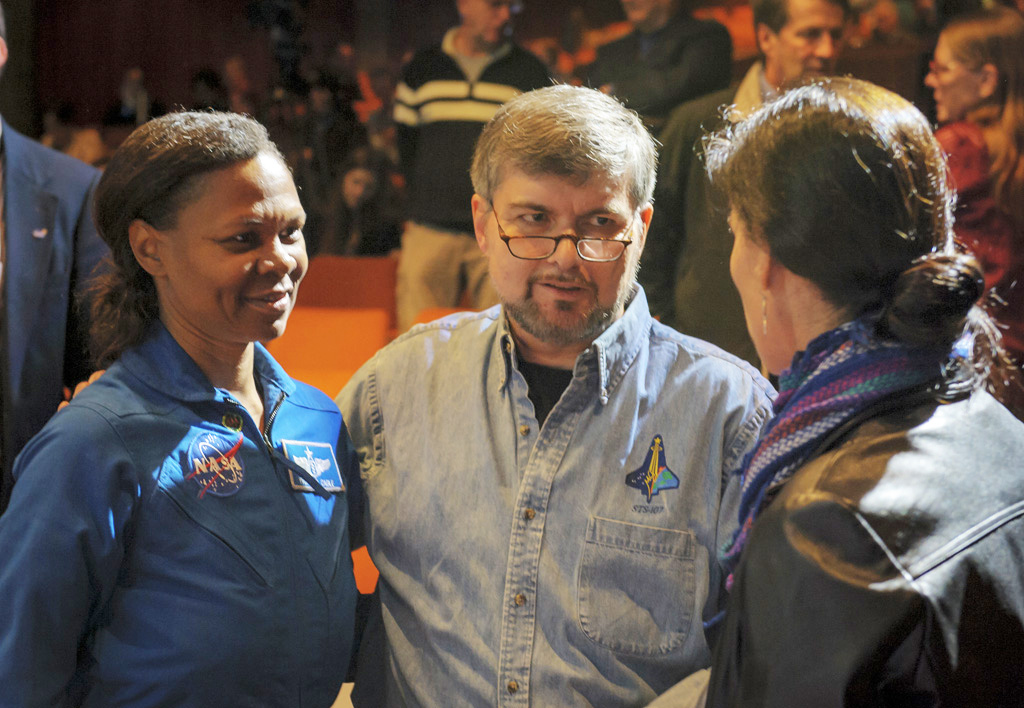
The Owls share their wisdom during visit, tour of Ames
At the invitation of Ames Center Director Eugene Tu, a group from the Owl Feathers Society visited here March 22, 2016, to present thoughts about NASA at this historical moment. As a 30-year employee at NASA Ames, Tu appreciates the mentoring and advice that previous generations of Ames leaders provided to him.
The Owls are a group of Ames retirees who began meeting in 1983, at quarterly lunches with technical presentations by current Ames researchers. They take their name from the final research project of Harvey Allen, in which he moved an owl feather through a bathtub to discover that owls flew upon their prey so silently because of small protruding feathers on the leading edge of their wings. The Owls have no formal leader, though Tom Snyder and Vic Peterson these days send out most of the emails.
After a center overview given by Tu, they were escorted on a short tour to see the NASA Advanced Supercomputing Facility to see the hyperwall. Afterwards, there was a briefing by the deputy center director Tom Edwards about Ames’ vision for the future and our activities towards that goal. They were then given a briefing and demonstration about SmallSats by Scott Richey. From there, it was lunch at Mega Bites to share their thoughts about what they had just seen and heard, and a question-and-answer period with Krisstina Wilmoth to ascertain where they thought Ames should be in the future. There are plans for them to return and be interviewed on camera, for posterity.
NASA Ames team meets Silicon Valley’s future engineers
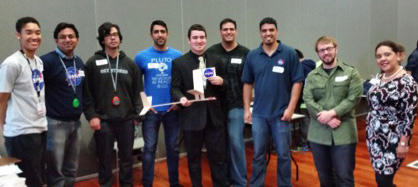
MESA Day is an annual science Olympics type competition event where more than 750 Mathematics, Engineering, Science Achievement (MESA) middle school and high school students from Santa Clara County showcase their Science, Technology, Engineering and Math (STEM) projects. The 2016 San Jose State University MESA Day was held on March 5, 2016, and NASA Ames volunteers judged the balsawood glider competition. The judging scored longest flight time in seconds for middle school students and longest flight time in seconds and a three-view drawing for high school students.
Ames African American Advisory Group member Alex Langford served as the lead judge and stated, “Seeing the students so enthusiastic when their gliders flew was inspiring. Everyone had fun no matter how well their glider flew.” Most notably, former NASA Ames intern and MESA alumnus, Gabriel Alvarez, who now works as a thermal R&D engineer with Space Systems Loral, also served as a balsawood glider judge. Alvarez was an intern within the Ames Engineering Systems Division and was involved with environmental testing for TechEdSat, engineering support for SPHERES and thermal analysis and design for the Mission Design Center. Alvarez credited his NASA experience, “My NASA internship helped give me a hands-on experience of actual flight hardware and design. By working on small satellites at Ames, I was exposed to many engineering subsystems and their integration. I now focus specifically on the thermal subsystem, but the design of the thermal subsystem is contingent from inputs from other subsystems, like electrical, structural and orbits. Having the opportunity with NASA definitely helped give me the big picture philosophy to do thermal analysis and design.”
All in all, the NASA team enjoyed the day spent with the potential rising aerospace engineers and sharing their experience at NASA with the engaged and excited students.
Lightfoot and Roe provide updates
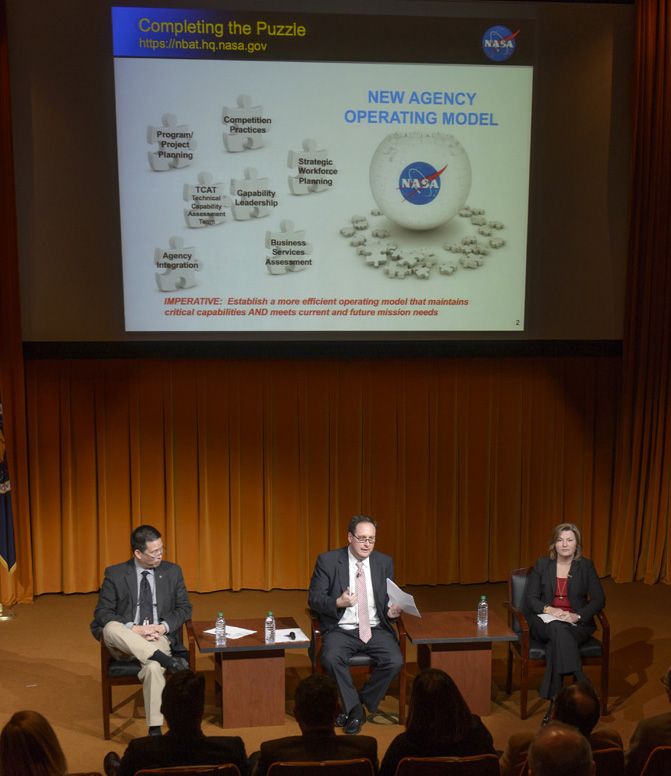
Mexico’s Space Agency visits
Israel’s ambassador visits
U.S. Congressman Thompson stops by
Our Contribution to Understanding Climate Change and Other Global Processes: A poster session held
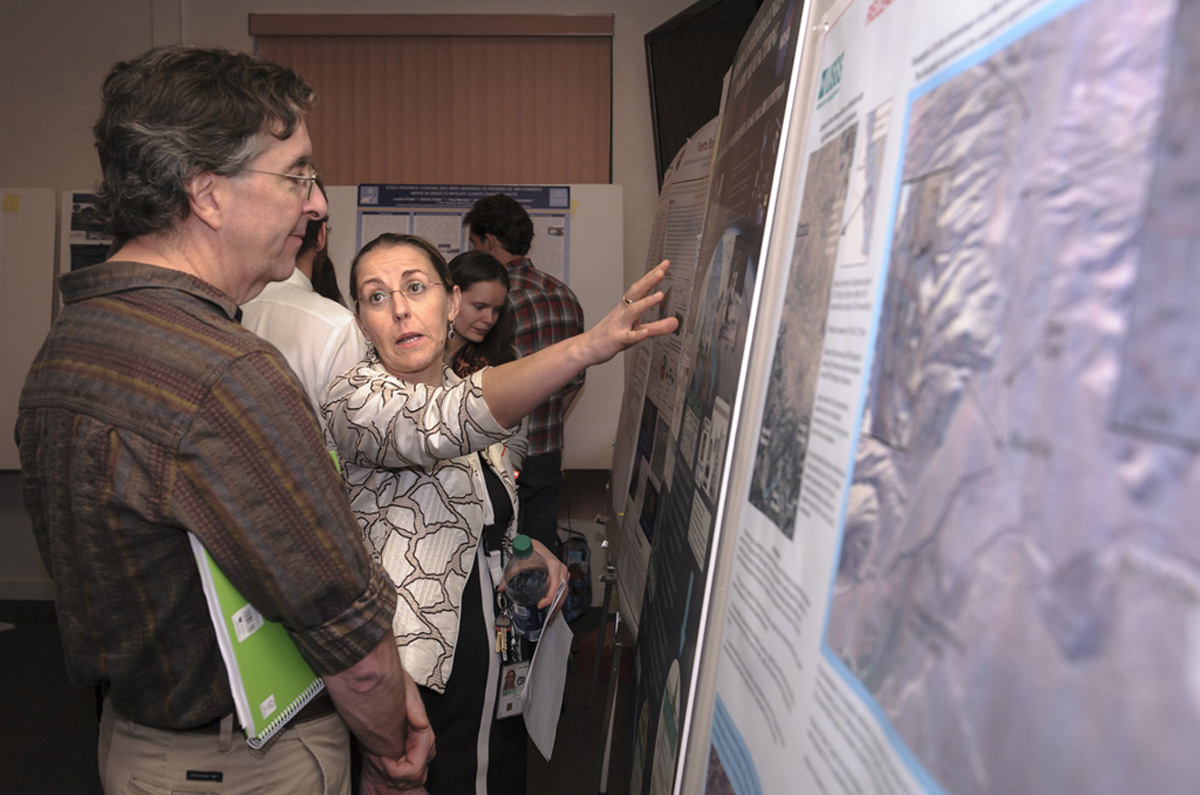
All employees, disabled or not, can work well together
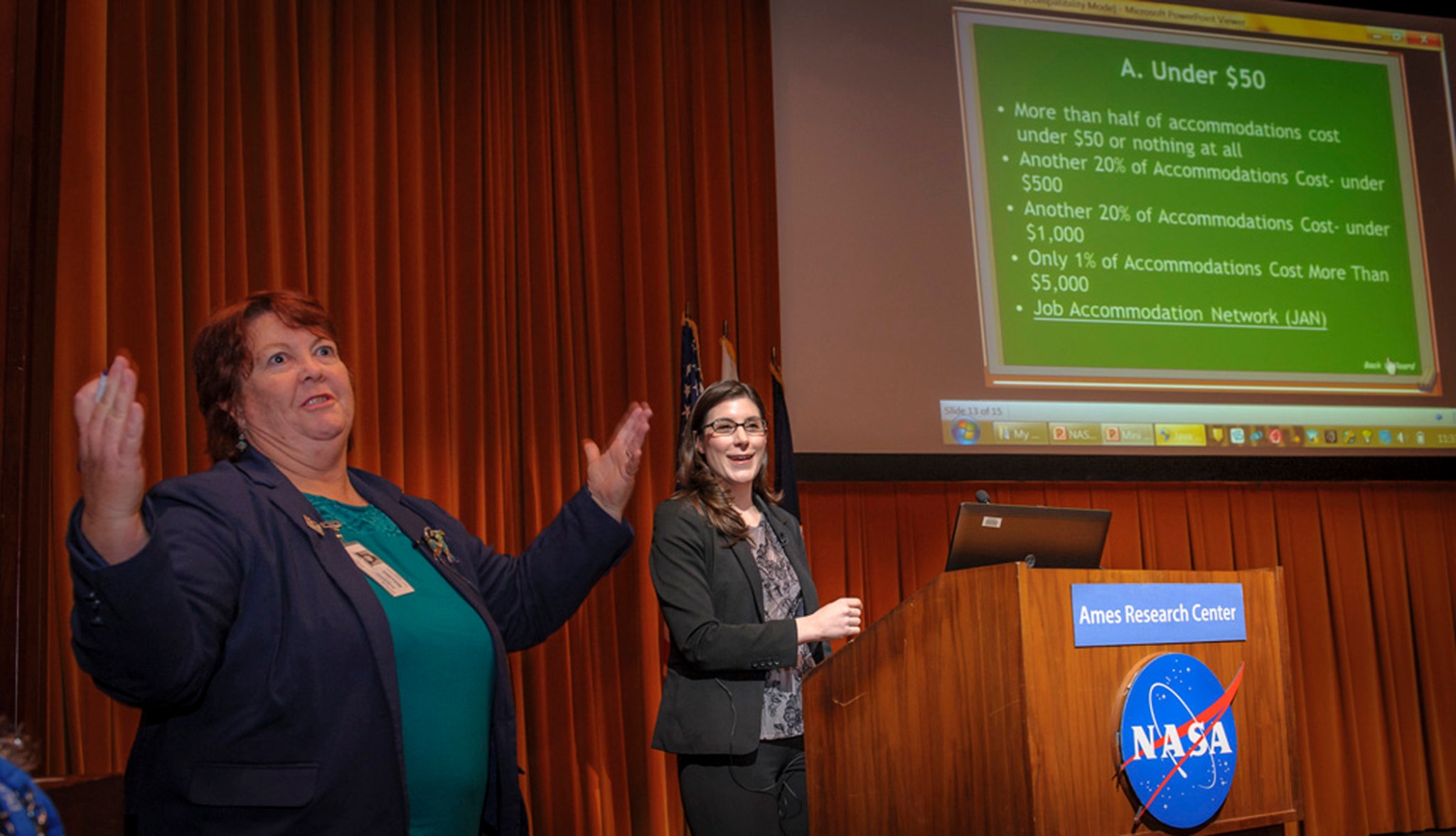
Ames researchers win coveted innovation grants from USGS
How can the advanced technologies developed at NASA Ames be applied to solve urgent problems facing our nation’s Earth scientists? The U.S. Geological Survey’s (USGS) Innovation Center has awarded four new grants to NASA Ames researchers to find out.
Susan Frost (Code TI) will continue her work with USGS geophysicists Benjamin Brooks and Sarah Minson to use optical wing-deflection sensors in the estimation of fault creep rates. These rates are essential for determining the seismic hazard from faults.
Lynn Rothschild (Code SST) has teamed up with USGS biologist David Blehert to detect avian flu in migrating birds using synthetic biology. The ability to detect some strains of avian flu carried by wildlife in near real-time may allow us to limit transmission of this economically destructive pathogen.
Brian Coltin (Code TI) will be working with Marie Peppler and the national USGS flood-mapping team to operationalize image analysis tools. These tools will allow satellite/imagery-derived flood maps to be delivered to USGS field crews and first responders in near real-time.
Ames Engineering (Code R) joins a team of USGS biologists led by Susan De La Cruz to develop the next generation of wildlife tracking tools, a project that also advances co-development of lightweight technologies for SmallSat, UAS and other wildlife applications.
This year’s awards, worth approximately $200,000 will be administered under an Interagency Agreement between the USGS Innovation Center and NASA Ames. More than $700,000 has been awarded to NASA Ames researchers under this agreement as part of a broader strategy to identify and develop alignments between the two Agencies and pursue science opportunities from orbit to core. For more information, contact Jonathan Stock, director of USGS Innovation Center at jstock@usgs.gov.
Tabazadeh speaks about her scientific and personal journey
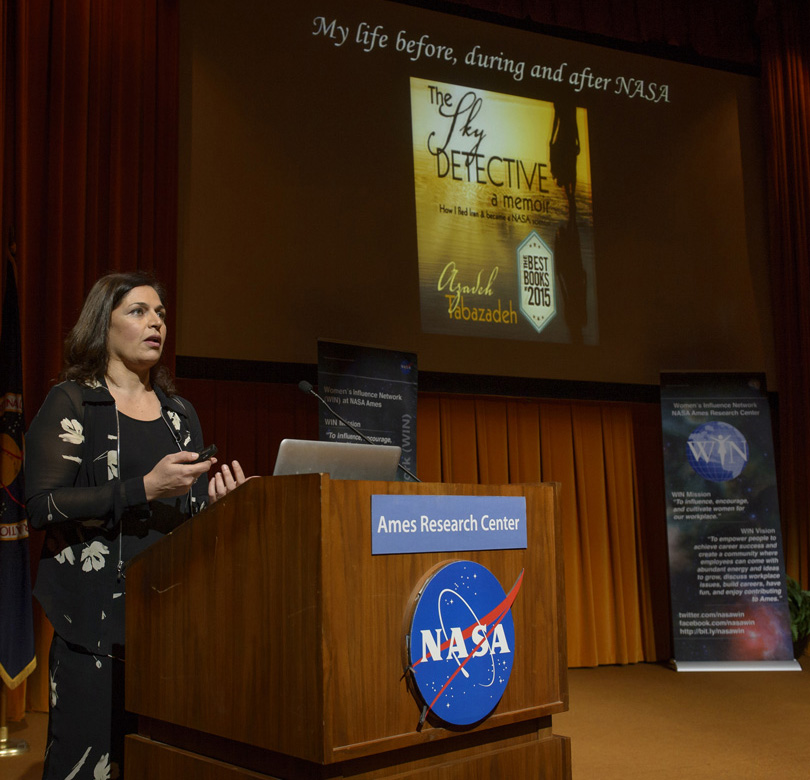
Brazilian Secretaries of Education examine program supported by HACE
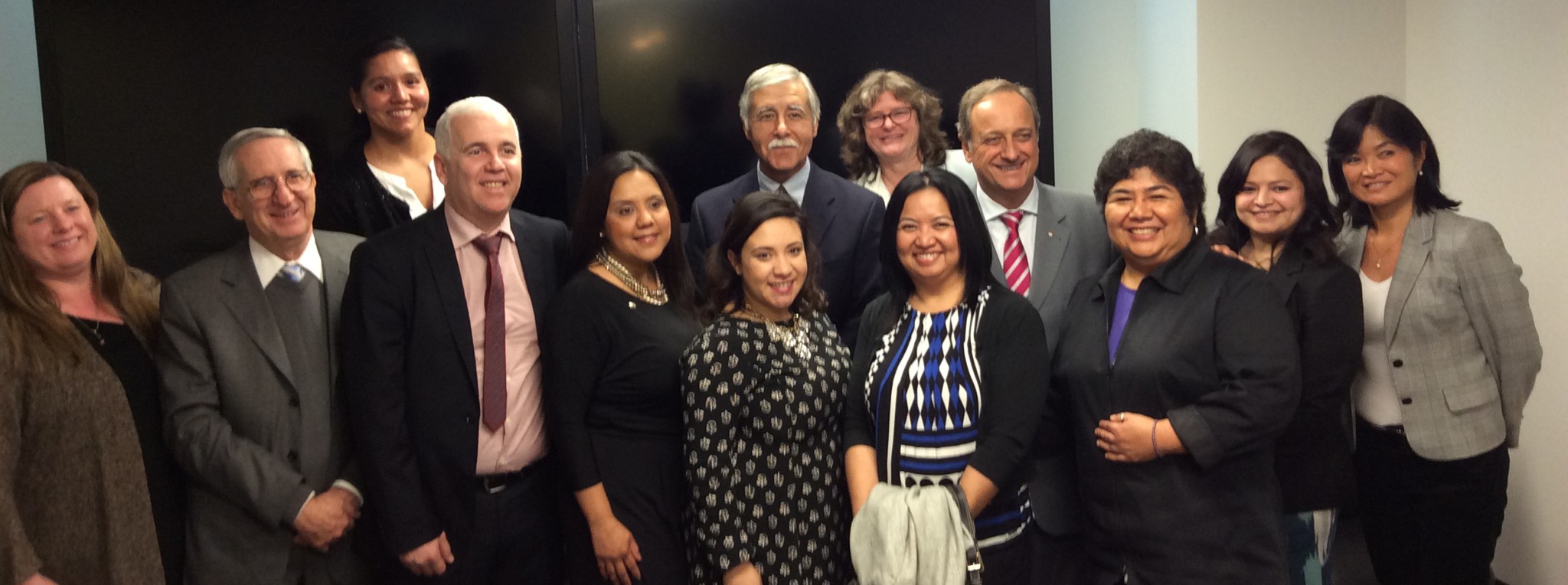
The Hispanic Advisory Committee for Employees (HACE) has promoted Science, Technology, Engineering, and Mathematics (STEM) exploration and careers amongst the Latino community, including a recent summit, presented by the Statewide Mathematics, Engineering, Science Achievement (MESA) Program, with Brazilian Secretaries of Education.
The United States Department of Education requested MESA to host the Brazilian Secretaries of Education, since MESA is nationally recognized for its innovative and effective academic development program for STEM fields and is exactly the type of STEM program Brazil is aspiring to implement.
Three Brazilian state secretaries of education visited the MESA Program at San Jose State University (SJSU) on Jan. 27, 2016, to explore replicating the program in their country. The summit included MESA program leaders; SJSU officials; MESA middle school and high school students; and Industry Advisory Board members, who obtain resources and volunteers within their companies in support of MESA initiatives. Maria Lopez, the NASA Ames liaison to the SJSU MESA Schools program, spoke about HACE’s association with MESA in alignment with the Federal STEM Education five-Year Strategic Plan, which includes increasing and sustaining youth and public engagement in STEM.
The MESA Program provides educationally and economically disadvantaged students with the skills and resources to be successful in school and careers in STEM disciplines. MESA provides a unique combination of enrichment activities, hands-on competitions, academic support, and industry involvement for students from the middle school level through college graduation. HACE has organized NASA participation from the advisory group members and the Center benefiting MESA via industry shadow days, judges for science Olympics, and motivational STEM career speakers for local MESA middle school and high school students. The summit validated HACE’s efforts to contribute to the success of MESA and the next generation of scientists, engineers, and entrepreneurs.
Ames female scientists, researchers discuss their careers
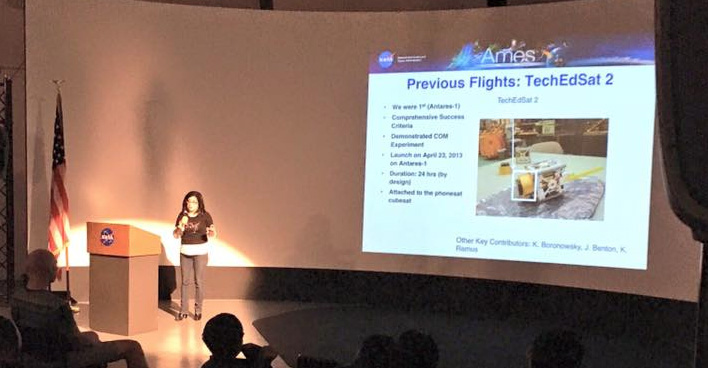
Employees pitch innovative ideas at first Ames Innovation Fair
Mission and Mission Support organizations were invited to propose their innovative ideas for the First Annual Ames Innovation Fair. The objective was to identify and provide resources to innovative projects that advance NASA’s mission goals. The Innovation Fair and associated collaboration website will offer new forums for collaboration and allow for employee advocacy in project selection.
This year, Ames will award at least $150K (up to $25K per award) and one FTE (up to 0.25 FTE per award) in total. Proposers pitched their innovation concepts at a one-day Innovation Fair on March 3, 2016. Posters were required for proposers and were be printed by the Innovation Fair coordinators.
NASA Ames employees had the opportunity to vote on their favorite concepts at the Innovation Fair and were treated to free pizza offered by the Ames Exchange. The top concepts will be added to the Center Innovation Portfolio.
All voting results will be provided to management and will be available online. Awards will be distributed this fiscal year (FY2016). A mix of mission and mission support innovations will be awarded.
The 2015 NASA FIRST team engaged employees across Ames about innovation. The team found that innovative ideas to advance the center’s future existed but could not move forward due to lack of a program for support. The concept of an Innovation Fair addresses this challenge by creating a pathway for support and was presented to center management.
Now, center management and other innovation efforts across the center (CIF, SIF, CAS) are working together to support the Innovation Fair.
For additional details see: https://intranet.share.nasa.gov/agency/amesinnovationfair
Blue Angels at Moffett, await their debut flyover at Superbowl 50

Front main gate reopens
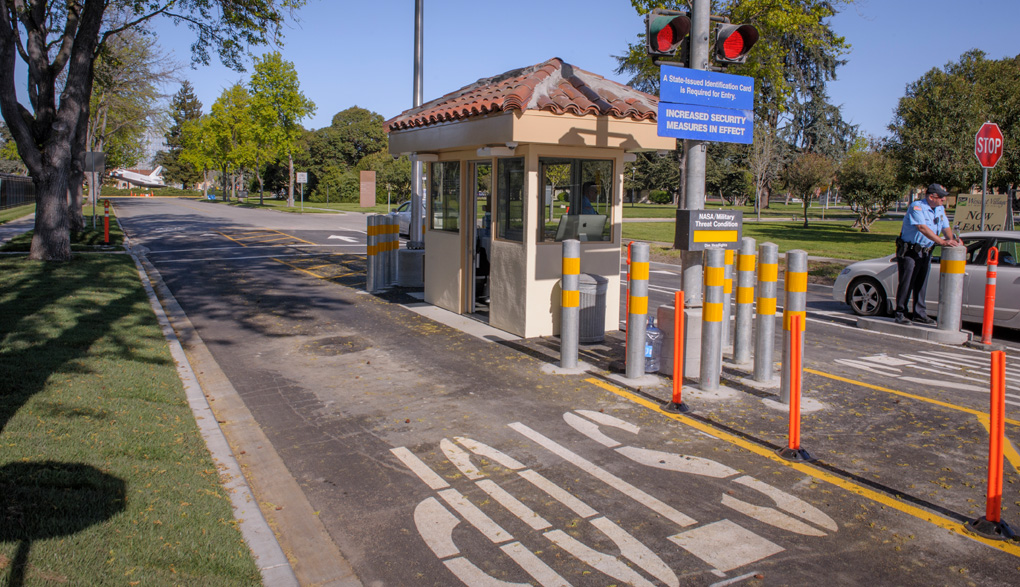
Ames ongoing monthly events calendar
African American Advisory Group (AAAG) Mtg., last Tuesday of each month, 12:00 – 1:00 p.m., Building N-255, Room 101C. POC: Porsche Parker, ext. 4-0044.
Asian American Pacific Islander Advisory Group (AAPIAG) Meeting, Third Thursday each month, 1:00 p.m. – 2:00 p.m., Building N213, Room 204A. POC: Tony Damian, tony.a.damian@nasa.gov
Moffett Aikido Club, Monday and Wednesday evenings, 6:30 p.m., Building 944. Aikido is a non-competitive, defensive martial art known as the “Way of Harmony.” POC: Diane Pereda (650) 575-9070 or Robert Dean (650) 787-1007, email: mfaikido@aol.com
Ames Amateur Radio Club, third Thursday of each month, noon, Building N-T28 (across from Building N-255). POC: George Tucker, at ext. 4-2200.
Ames Bluegrass Club, every Tuesday from 11:30 a.m. to 1:00 p.m. in Building 944. Players of all instruments and all levels are welcome, but we are particularly interested in experienced players willing to help improve the group’s musical skills. POC: Bob Haberle at ext. 4-5494 or email: robert.m.haberle@nasa.gov
Ames Bocce Ball Club, Ames’ newest Exchange-sponsored club is seeking members. POC: Mike Lindsay email: michael.c.lindsay@nasa.gov
Ames Bowling League, Thursdays, 6:15 p.m. at Fourth Street Bowl in San Jose. Need regular and subsitute bowlers. For sign up questions contact Michael Hom at ext. 4-0302 or Mina Cappuccio at ext. 4-1313.
Ames Contractor Council Meeting, first Wednesday of each month, 11:00 a.m., Building N-200, Committee Room. POC: Herb Finger at ext. 4-6598.
Ames Federal Employees Union (AFEU) Mtg.,third Wednesday of each month, Noon. Building N-204, Room 101. Guests welcome. Check for schedule changes at: http://www.afeu.org. POC: Paul K. Davis, ext. 4-5916.
Ames Golf Club, Members have the opportunity to play approximately 13 tournaments per year at a variety of 18-hole golf courses in the Bay and Monterey Area. POC: Barry Sullivan: Barry.T.Sullivan@nasa.gov.
The Hispanic Advisory Committee for Excellence (HACE) Meeting., first Thursday of each month, 11:30 a.m. – 12:30 p.m., Building N-255, Room 101C. POC: Jeanette Zamora, jeanette.zamora-ortega-1@nasa.gov.
Ames Jazz Band Club, Thursday evenings, 5:30 p.m. – 7:00 p.m., Building 944. POC: Ralph Bach, email: ralph.e.bach@nasa.gov
Jetstream Toastmasters, Mondays, 12:00 p.m. – 1:00 p.m., Building N-262, Room 100. POC: Tim Steiger, ext. 4-0195, tim.steiger@nasa.gov. Web: http://jetstream.freetoasthost.com
Native American Advisory Committee (NAAC) Bi-Monthly Meeting, First Thursday of the month, 11:00 a.m. – 11:45 a.m., Building 19, Room 1096. For more information contact Anita Abrego at Anita.I.Abrego@nasa.gov, or call ext. 4-2565.
Ames Nimble Knitters Club, Mondays, 11:30 a.m., Building. N-210, Room 141. POC: Diane Alexander at ext. 4-3140 or email diane.alexander-1@nasa.gov. All knitters and crocheters are welcome to attend and participate in our charity projects.
Ames Roller Hockey Club, meets daily from Noon to 1:00 p.m. at rink on north end of the 80-foot-by-120-foot wind tunnel. Players should have experience skating and must wear protective equipment. POC: James Prunty, james.a.prunty@nasa.gov
Ames Safety Committee, third Thursday of each month, 10:00 a.m. – 11:00 a.m., Building N-237, Room 200. POC: John Livacich, jlivacich@mail.arc.nasa.gov, ext. 4-3243.
Women’s Influence Network (WIN), first Wednesday of each month, Building N-244, Room 209, Noon – 1:00 p.m., POC: Ali Guarneros Luna, ali.guarnerosluna@nasa.gov
Exchange Information
Information about products, services and opportunities provided to the employee and contractor community by the Ames Exchange Council. Visit our web site at: http://exchange.arc.nasa.gov
Beyond Galileo Gift Shop N-235 in the cafeteria, 8:00 a.m. – 2:00 p.m., ext. 4-6873
Visitor Center Gift Shop (Exploration Center), Tues-Fri, 10:00 a.m. – 4:00 p.m., Sat. – Sun, noon – 4:00 p.m., ext. 4-5412
Remember to purchase your baby shower, birthday and holiday gifts at Ames’ two gift shops!
Mega Bites Cafeteria N-235, Mon – Fri, 6:00 a.m. – 2:00 p.m., ext. 4-5969/Catering ext. 4-2161
The SpaceBar: Subs & Burgers, Bldg. 3, The SpaceBar is open Mon through Fri from 7:30 a.m. – 7:00 p.m. Continental breakfast and coffee starting at 7:30 a.m. with full food and beverage service 11:00 a.m. to 7:00 p.m. See: http://exchange.arc.nasa.gov/cafe/menu.html for menu items.
RV lots available. Call to reserve a space at (650) 604-0698. Civilian/Contractors, $50/mo; military $25/mo
NASA Lodge (Bldg. 19) (650) 603-7100
Where to stay when you’re too tired to drive home? What about the lodge?! Two types of rooms: Bldg. 19 (43 rooms), rate: $65/night ($5 ea add’l adult); Bldg. 583 A&B (150 rooms), rate: $55/night ($5 ea. add’l adult); B547 rate $60/night (for large groups)
Ames Swim Center (N-109) (650) 603-8025
The swimming pool is now open. Hours of operation are as follows (lap swim only):
MWF 10:00 a.m. – 1:00 p.m.
MWF 3:00 p.m. – 6:00 p.m.
TTH 10:00 a.m. – 1:00 p.m.
TTH 4:00 p.m. – 7:00 p.m.
The pool is heated year round. The pool normally is available for lap swim, pool parties and special events. POC: Ryan Storms, pool manager (650) 603-8025. Memberships: single memberships: $60/yr. Family memberships: $80/yr. After purchasing a membership, there is an entrance fee: daily entrance fee – $3/day or lap pass fee – $50 for 20 uses. Platinum membership – $380/yr. (no daily fee). Special events include military training, swim team events, kayak role practice, etc. The cost for special events is $75/hr, or $50/hr for military.
Exchange basketball gym, Bldg. 2
(650) 603-9717
Hours of operation:
M-F 11:00 a.m. – 1:30 p.m.
M-F 4:00 p.m. – 7:00 p.m.
Chase Park reservations, call ext. 4-4948
NACA Park reservations, call ext. 4-4948
Ames emergency announcements
To hear the centerwide status recording, call (650) 604-9999 for information announcements and emergency instructions for Ames employees. You also may listen to 1700 KHz AM radio for the same information.
Ames Cat Network
The Ames Cat Network needs help finding homes for cats trapped at Moffett. They range from feral to abandoned/lost pets. They are tested, altered and inoculated. Call Iris at ext. 4-5824 if you or someone you know are interested in fostering or adopting a cat.
National Aeronautics and Space Administration
Ames Research Center
Moffett Field, CA 94035-1000
The Ames Astrogram is an official publication of Ames Research Center, National Aeronautics and Space Administration.
Managing Editor………………….Matthew Buffington
Editor, Layout and Design……………Astrid Albaugh
Employees can reach the Astrogram Office via email at: astrogram@mail.arc.nasa.gov or by phone at ext. 4-3347. For downloadable pdf copies of each issue, visit the Astrogram website at:
https://www.nasa.gov/ames/astrogram

